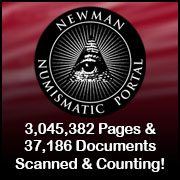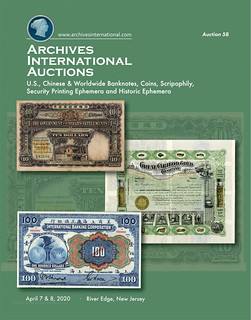
About UsThe Numismatic Bibliomania Society is a non-profit association devoted to the study and enjoyment of numismatic literature. For more information please see our web site at coinbooks.org SubscriptionsThose wishing to become new E-Sylum subscribers (or wishing to Unsubscribe) can go to the following web page link MembershipThere is a membership application available on the web site Membership Application To join, print the application and return it with your check to the address printed on the application. Print/Digital membership is $40 to addresses in the U.S., and $60 elsewhere. A digital-only membership is available for $25. For those without web access, write to: Charles Heck, Treasurer
AsylumFor Asylum mailing address changes and other membership questions, contact Chuck at this email address: treasurer@coinbooks.org SubmissionsTo submit items for publication in The E-Sylum, write to the Editor at this address: whomren@gmail.com BUY THE BOOK BEFORE THE COINSale Calendar |
- WAYNE'S WORDS: THE E-SYLUM APRIL 8, 2020
- NEW BOOK: HIDDEN POWER
- NEW BOOK: MODERN CHINESE PAPER MONEY
- NEW PODCAST: THE PLANCHET
- AUDIO: STACK'S AT 57TH STREET
- PERIODICAL: PAPER MONEY MARCH/APRIL 2020
- PERIODICAL: IBNS JOURNAL SUMMER 2020
- ANS DIGITIZING MEDIEVAL AND MODERN COLLECTION
- ANS UPDATES GREEK NUMISMATIC DATABASE: PELLA
- VIDEO: COINS THAT REVEALED A CRIME RING
- VIDEO: STUDENT ERIC LINDHOLM INTERVIEWED
- APRIL FOOLS 2020
- THE ANA CONVENTION THAT WASN'T: 1918
- QUERY: 1912 CHAPMAN EARLE SALE PHOTO CAPTION
- KENT PONTERIO ON THE STATE OF THE MARKET
- CORONAVIRUS UPDATES: APRIL 5, 2020
- NOTES FROM E-SYLUM READERS: APRIL 5, 2020
- DAVID FANNING REQUESTS RESEARCH ASSISTANCE
- DEFACING COUNTERMARKED COINS MYSTERY WORD
- NATIONAL ARCHIVES TRANSCRIPTION UPDATE
- THE 1953 EMPEROR NORTON MEDALS
- VOCABULARY TERM: KNUCKLE-JOINT PRESS
- CALVIN WESTLEY FRANKLIN (1854-1911)
- CSNS PRESIDENT ANNOUNCES 2020 SOWER RECIPIENTS
- NATIONAL EMERGENCY LIBRARY ANNOUNCED
- ROBINSON ANCIENT COIN SALE 112 ANNOUNCED
- ARCHIVES INTERNATIONAL SALE 58 ANNOUNCED
- SELECTIONS FROM HOLABIRD APRIL 2020 SALES
- SELECTIONS FROM HERITAGE APRIL 2020 SALES
- ROMAN COIN HOARD FOUND IN HRUBIESZóW POLAND
- EXHIBIT: MEDIEVAL EASTERN MEDITERRANEAN COINAGE
- SCHOOL'S MUSEUM GAINS OFFICIAL RECOGNITION
- WILLIAM JAMESON – AN UNLIKELY MINT DIRECTOR
- U.S. MINT PATENTS METAL ALLOY FOR COIN PRODUCTION
- GERMS AND MONEY
- HISTORY OF MONEY CLEANING
- THAILAND ISSUES NEW COINS TO CURB CORONAVIRUS
- SAM ALFANO'S SHERLOCK HOLMES HOBO NICKEL
- 1867 MONTGOMERY ANTICIPATION NOTES
- ANA BEBEE COLLECTION'S UNCUT SHEETS CERTIFIED
- ARTISTS USING MONEY AS A METAPHOR
- LOOSE CHANGE: APRIL 5, 2020
- 100CORONA VIRUS STRIKES COIN COLLECTIONS
Click here to access the complete archive
To comment or submit articles, reply to whomren@gmail.com
Content presented in The E-Sylum is not necessarily researched or independently fact-checked, and views expressed do not necessarily represent those of the Numismatic Bibliomania Society.
WAYNE'S WORDS: THE E-SYLUM APRIL 8, 2020
 This week is a two-fer: we open with two new books, two podcasts, two videos, and two updates from the American Numismatic Society.
This week is a two-fer: we open with two new books, two podcasts, two videos, and two updates from the American Numismatic Society.
Other topics this week include last week's April Fools articles, more hobby coronavirus updates, defaced countermarked coins, Emperor Norton medals, multiple numismatic sale previews, germs and money, revenue anticipation notes, and money art.
To learn more about Chinese paper money, the Progressional Coin Grading Service, the Del Monte note, the ANA convention that wasn't, currency printing presses, knuckle-joint coining presses, Government of Texas notes, the Acme beer token, the Elizabeth I gold ship ryal, money as a metaphor, the urine tax, and the unlikely Director of the Quito mint in Ecuador, read on. Have a great week, everyone!
Wayne Homren
Editor, The E-Sylum
NEW BOOK: HIDDEN POWER
The American Numismatic Society has announced a new publication: Hidden Power: Late Cistophoric Production and the Organization of Provincia Asia (128–89 BC) by Lucia Francesca Carbone. -Editor
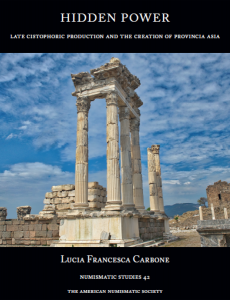 Hidden Power: Late Cistophoric
Production and the Organization of Provincia Asia (128–89 BC)
Hidden Power: Late Cistophoric
Production and the Organization of Provincia Asia (128–89 BC)
(Numismatic Studies 42)
by Lucia Francesca Carbone
List price: $100 plus shipping & handling
Member price: $70 plus shipping & handling
ISSN 0517-404X
ISBN 978-0-89722-363-8
Hardcover, vii + 266 text pages, b/w figs., 142 b/w plates containing images of 1,737 coins.
Using the production and circulation patterns of the Asian cistophorus as a case study, Hidden Power seeks to develop a better understanding of Roman monetary policy in the province of Asia between its establishment in the 120s BC and the beginning of the Mithraditic Wars.
Hidden Power catalogues and illustrates some 1,737 cistophoric tetradrachms and fractions from the mints of Ephesus, Pergamum, Tralles, Laodicea, Apamea, Adramyteum, Nysa, and Smyrna. Most of the coins included in the study are late cistophori, issues between 134.3 BC and the 60s BC.
Appendix I provides a discussion of the late cistophori of Tralles struck after 89 BC, showing not only the direct correlation between cistophori and Roman military campaigns, but also Roman taxation.
In Appendix II, circulation data have been combined with data derived from the Tralles die study in order to calculate cistophoric production for the entirety of provincia Asia until the end of the late cistophori. This estimate provides a means to assess the financial impact of Roman taxation and exploitation by Roman imperatores over the course of the first half of the first century BC.
ABOUT THE AUTHOR
Lucia Carbone is an ancient historian and numismatist who holds BA and MA degrees from Università Sapienza (Rome) as well as MPhil and PhD degrees from Columbia University (New
York). She is currently the Assistant Curator for Roman Coins at the American Numismatic Society. Her main research interest is the impact of Roman imperialism on the monetary and
administrative systems of the eastern provinces of the Roman Empire between the second and first centuries BC.
ORDER NOW
Order this title from our distributor, Casemate Academic/Oxbow Books. ANS Members, use your discount code at checkout. Forgot the code? Email Emma Pratte, or call 212.571.4470
x117.
For more information or to order, see:
Hidden Power ns42Late Cistophoric Production and the Organization of Provincia Asia (128–89 BC)
(http://numismatics.org/store/ns42/)
NEW BOOK: MODERN CHINESE PAPER MONEY
CDN Publishing is offering a digital book by Patrick Ian Perez in collaboration with The Banknote Book on modern Chinese paper money. -Editor
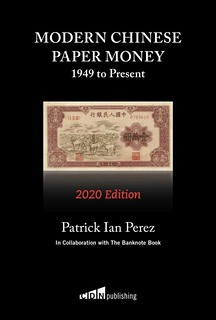 This ground-breaking
reference is the only English-language reference of its kind" on this popular collectible.
This ground-breaking
reference is the only English-language reference of its kind" on this popular collectible.
Chinese paper money, in particular the banknotes issued by the People's Bank of China beginning in 1949, have been among the fastest growing and most popular areas of collectible world paper money.
All dealers and collectors of world paper money will find this reference highly useful.
This reference catalog is sold as an annual subscription, meaning you will have access to it for 12 months after you purchase it. We will make continuous updates and your subscription will always give you access to the latest edition (via PDF download).
Features include:
• Current Pricing: we cover (7) different grades with pricing for each note, including three levels of Uncirculated as assigned by third-party grading services.
• Hi-rez photographs: to help you quickly and correctly identify these notes and their values.
• Counterfeit detection: a special section on counterfeits, written by Joseph E. Boling, one of the world's leading experts on authentication of collectible paper money.
• Amazon Kindle edition: also available on Amazon Kindle.
1 Year PDF Access $29.95
For more information, or to order, see:
Modern Chinese Paper Money: 1949 to Present
(https://www.greysheet.com/Publications/modern-chinese-paper-money)
NEW PODCAST: THE PLANCHET
The American Numismatic Society has launched a new podcast. Here's the announcement and details on the first episode. -Editor
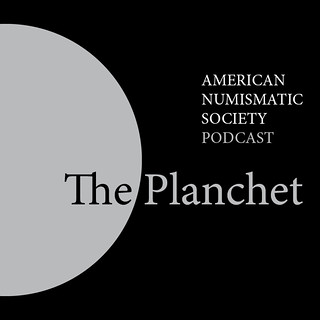 The ANS has launched a podcast! Hosted by our
Publications Director Andrew Reinhard, each episode of The Planchet will be a conversation with numismatists covering a range of topics. Episode 1 features ANS Assistant
Curator of the Americas Dr. Jesse Kraft on how Americans spent foreign currency before the Coinage Act of 1857. The Planchet is available on Apple Podcasts, Spotify,
Stitcher, and Google/Android. Subscribe and hear a new episode each month!
The ANS has launched a podcast! Hosted by our
Publications Director Andrew Reinhard, each episode of The Planchet will be a conversation with numismatists covering a range of topics. Episode 1 features ANS Assistant
Curator of the Americas Dr. Jesse Kraft on how Americans spent foreign currency before the Coinage Act of 1857. The Planchet is available on Apple Podcasts, Spotify,
Stitcher, and Google/Android. Subscribe and hear a new episode each month!
Episode 1: ?Jesse Kraft, ?ANS Curator of the Americas
 From the earliest days of the British-American colonies, up
through the late 1850s, a variety of foreign coinage circulated in the United States, including Spanish-American, British, French, and Portuguese formed a majority of the
hard-money supply in the United States. Most of these coins did not conform to the predominant unit of account (i.e. “dollars” or “pounds”) and forced American consumers and
merchants to navigate this system through a variety of ingenious, though sometimes confounding methods. This episode will discuss those methods, including the use of abstract
mathematical formulas, a variety of exchange charts, the prolonged usage of British monetary terminologies, and ways to evade the heightened threat of counterfeit coins.
From the earliest days of the British-American colonies, up
through the late 1850s, a variety of foreign coinage circulated in the United States, including Spanish-American, British, French, and Portuguese formed a majority of the
hard-money supply in the United States. Most of these coins did not conform to the predominant unit of account (i.e. “dollars” or “pounds”) and forced American consumers and
merchants to navigate this system through a variety of ingenious, though sometimes confounding methods. This episode will discuss those methods, including the use of abstract
mathematical formulas, a variety of exchange charts, the prolonged usage of British monetary terminologies, and ways to evade the heightened threat of counterfeit coins.
In her email Newsletter #149 Shanna Schmidt writes:
"I thoroughly enjoyed listening to the maiden podcast featuring Dr. Jesse Kraft of the ANS. It mattered very little that he was discussing American coinage, I am a lover of history and found the podcast entertaining and easy to follow."
For more information, or to listen, see:
The Planchet The Podcast from the American Numismatic Society (http://numismatics.org/planchet/)
AUDIO: STACK'S AT 57TH STREET
The latest CoinWeek podcast features Harvey Stack reflecting on his family firm's days at their 57th Street address. -Editor
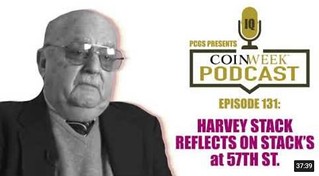 Hi Everybody,
this is Charles Morgan from CoinWeek.
Hi Everybody,
this is Charles Morgan from CoinWeek.
I'm delighted in the midst of our nationwide lockdown to bring you one of the coin collecting hobby's preeminent figures. Harvey Stack has worked as a professional numismatist his entire life. Son of another legendary numismatist, Morton Stack, Harvey has served the numismatic community in New York City and across the country as the head of the family business, Stack's– which since the 1950s has been located at 57th street in the heart of midtown Manhattan.
To listen, see:
CoinWeek Podcast #131: Harvey Stack Reflects on Stack's at 57th
Street (https://coinweek.com/video-news/coinweek-podcast-131-harvey-stack-reflects-on-stacks-at-57th-street/)
To read the earlier E-Sylum articles, see:
STACK'S BOWERS ON THE MOVE IN NEW YORK (https://www.coinbooks.org/v23/esylum_v23n08a19.html)
HARVEY STACK ON STACK'S 123 WEST 57TH STREET LOCATION (https://www.coinbooks.org/esylum_v17n44a30.html)

PERIODICAL: PAPER MONEY MARCH/APRIL 2020
The Society of Paper Money Collectors (SPMC) has published the latest issue of Paper Money. At my request editor Benny Bolin kindly forwarded the table of contents and an excerpt of an article of interest to students of post Civil War obsolete notes (appearing elsewhere in this issue). Thanks! -Editor
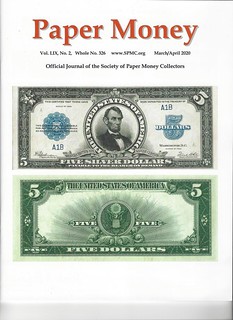 Series of 1923 Porthole
S.C. Doomed—Lee Lofthus
Series of 1923 Porthole
S.C. Doomed—Lee Lofthus
The Series of 1923 $5 “porthole” silver certificates may appear to be a simple one-and-done type note from a numismatic perspective, but the governmental story behind them was
hardly simple.
$1 Series of 1899 S.C. Signature Combinations--Peter Huntoon
Identification of the known engraving varieties on the intaglio face and back plates used to print the Series of 1899 $1 silver certificates and a timeline for when those plates
were on the presses is presented.
The Delaware & Hudson Canal & its Paper Money—Q. David Bowers
Obsolete banknotes from the Delaware & Hudson Canal that started in his hometown.
WW2 British Military Authority Notes for Greece--Evangelos Fys
Under Law 18 of 9th November 1944 it was decided that British Military Authority banknotes would circulate along with the new currency in Greece.
Commonwealth Edison's Federal Dividend Coupon System—Loren Gatch
A part of ComEd's strategy was its marketing of consumer appliances and electrical accessories through outlets called “Edison Electric Shops.” One aspect was its use of the
Federal Dividend Coupon System.
Seal Varieties on Series 1928 FRNs—Peter Huntoon
An update to an earlier article in Paper Money announcing the discovery of a matching star note.
The County of Montgomery (AL) & Their Revenue Notes—Bill Gunther
Immediately after the Civil War states, cities and counties throughout Alabama found themselves bankrupt and without a major source of revenue. A partial solution, adopted by many
cities and counties, was to pay their obligations with post-dated notes.
For more information on the Society of Paper Money Collectors, see:
https://www.spmc.org/
PERIODICAL: IBNS JOURNAL SUMMER 2020
IBNS members can look forward to reading the Summer 2020 issue of the International Bank Note Society Journal. It's available for download on the group's web site (membership required). -Editor
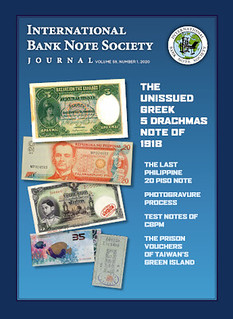 TABLE OF CONTENTS
TABLE OF CONTENTS
• President's Message
• I.B.N.S. Hall of Fame
• From The Editor
• Banknote News
• A Perfect Pair: Miguel Grau & Arturo Prat
• The Unissued Greek 5 Drachmas Note of 1918
• The Last Philippine 20 Piso Note
• Photogravure Process
• Test Notes of CBPM Including the World Record Test Note
• The Prison Vouchers of Taiwan's Green Island
• Book Review: The Banknote Book: Ukraine
• Book Review: The Banknote Book: Ukraine
• New Issues
• News From The Chapters
• Society Officers
• New Members
For more information about the International Bank Note Society, see:
https://www.theibns.org/
ANS DIGITIZING MEDIEVAL AND MODERN COLLECTION
The American Numismatic Society announced a new program to digitize its Medieval and Modern Collection. Great news! -Editor
Digitizing the Medieval and Modern Collection
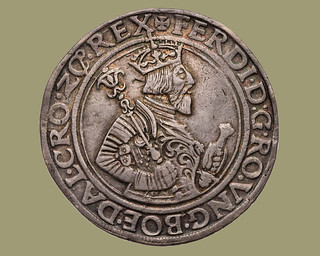 We are pleased to announce that the ANS will begin
enhancing and further developing the digitization of our Medieval and Early Modern Collection, with an emphasis on the approximately 22,000 coins that represent Europe in the
years 1500–1700.
We are pleased to announce that the ANS will begin
enhancing and further developing the digitization of our Medieval and Early Modern Collection, with an emphasis on the approximately 22,000 coins that represent Europe in the
years 1500–1700.
?This vital area of the Society's collection can now be addressed thanks to a grant from an anonymous donor of up to $200,000 over 12 months, which will help support this project. This magnanimous donation comes at a critical time for the ANS, which like many other nonprofits is being challenged by the ongoing economic crisis resulting from the COVID-19 pandemic. Such a financial investment in the Society's future provides encouragement and inspiration to us all.
ANS UPDATES GREEK NUMISMATIC DATABASE: PELLA
The American Numismatic Society has announced an update of PELLA, their online catalogue of the coinage produced by the kings of the Macedonian Argead dynasty (c.700–310 BC). Here's the press release. -Editor
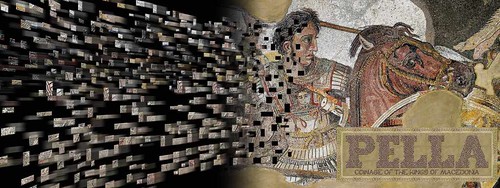
The ANS is pleased to announce that an updated version of PELLA (numismatics.org/pella) has now been launched. As a component of the National Endowment of the Humanities funded Hellenistic Royal Coinages project, PELLA is an innovative research tool aiming, among other things, to provide a comprehensive typology and catalog of the coinages struck by the Macedonian kings of the Argead dynasty (c. 700–310 BCE), arguably the most influential coinages of the ancient Greek world. Fueled first by indigenous precious metal mines in their native Macedonia, and later by the spoils of their conquests, including the rich treasures of the Persian Empire, the Argeads' numismatic output was monumental.
For centuries after their deaths, coins in the name of Philip II (ruled 359–336 BCE) and Alexander the Great (ruled 336–323 BCE) continued to be produced by successor kings, civic mints, and imitators from Central Asia to Central Europe. The coinage of the Argeads themselves and that produced in their names has been extensively studied, but to date no comprehensive, easily accessible catalog of their coinages exists. PELLA is designed to fill that gap, cataloging the individual coin types of the Argead kings from Alexander I (ruled 498–454 BCE), the first of the Macedonian kings to strike coins, down to Philip III Arrhidaeus (ruled 323–317 BCE), the last of the titular kings to do so. Included as well as are the numerous posthumous civic and successor coinages struck in the names of the kings.
The updated version now includes the coinage (in the name of) Philip II, which is organized using George Le Rider's Le monnayage d'argent et d'or de Philippe II frappé en Macédoine de 359 a 294, 1977. This material joins the existing coinage (in the name) of Alexander III and Philip III, which is organized using reference numbers from Martin Price's The Coinage in the Name of Alexander the Great and Philip Arrhidaeus, London 1991. The updated version of PELLA now provides links to over 20,000 examples of the coinage (in the name) of Philip II, the coinage (in the name) of Alexander the Great, and the coinage of Philip III Arrhidaeus that are present in 19 collections located in the United States and Europe. “This expansion of PELLA,” noted Project Co-Director Dr. Peter van Alfen, Chief Curator at the ANS, “greatly enhances our Hellenistic Royal Coinages suite of online resources. Philip II's coinage was hugely important and influential, so having this material available for use and study will be a great benefit for numismatists, scholars, and collectors alike.”
To visit PELLA, see:
http://numismatics.org/pella/
To read the earlier E-Sylum article, see:
ANS LAUNCHES GREEK NUMISMATIC RESEARCH TOOL: PELLA (https://www.coinbooks.org/esylum_v18n47a05.html)
The ANS is also seeking donations to help fund major new research in another popular digital database—Online Coins of the Roman Empire (OCRE). Here's the press release. -Editor
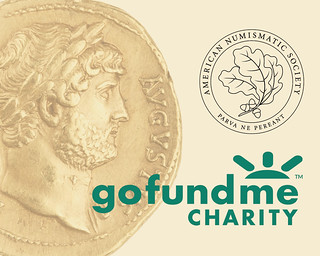 The American Numismatic Society aims to
incorporate major new research on Roman Imperial Coinage into its hugely popular digital resource Online Coins of the Roman Empire. This is a laborious process that entails
updating or amending thousands of entries, and it will take several months to complete. In order to assist this project, the ANS has launched a gofundme campaign on its charity
platform.
The American Numismatic Society aims to
incorporate major new research on Roman Imperial Coinage into its hugely popular digital resource Online Coins of the Roman Empire. This is a laborious process that entails
updating or amending thousands of entries, and it will take several months to complete. In order to assist this project, the ANS has launched a gofundme campaign on its charity
platform.
Since its inception in 2013, Online Coins of the Roman Empire (OCRE) has provided the numismatic community with a revolutionary tool designed to help in the identification, cataloging, and research of the rich and varied coinage of the Roman Empire. OCRE provides an easy to use digital resource incorporates over 43,000 types of coins and more than 130,000 physical coins, representing more than 40 major public and private collections from all over the world. The project records every published type of Roman Imperial Coinage from Augustus, in 31 BCE, until the death of Zeno, in 491 CE.
In January 2019, Spink & Son published Roman Imperial Coinage, Vol. II, Part 3, written by longtime British Museum curator Richard Abdy, with a section on medallions by P. F. Mittag. This was the first new volume in the series in 25 years, and it represents a major achievement in the field. For the ANS, this important new work, which covers the reign of Hadrian (117–138 CE), necessitates the hiring of temporary staff to aid in the replacement of some 4,000 OCRE records. The Society, in cooperation with Sprink & Sons and Richard Abdy, is now working on this process, which will take several months. The ANS is therefore asking for small donations to help integrate this very significant improvement into the online project. If you use OCRE for teaching or research, please consider donating to the ANS. No amount is too small.
The American Numismatic Society, organized in 1858 and incorporated in 1865 in New York State, operates as a research museum under Section 501(c)(3) of the Internal Revenue Code and is recognized as a publicly supported organization under section 170(b)(1)(A)(vi) as confirmed on November 1, 1970.
To donate, see:
Updating OCRE (https://charity.gofundme.com/o/en/campaign/updating-ocre)
To read the complete press release, see:
THE ANS LAUNCHES AN ONLINE FUNDRAISING CAMPAIGN FOR OCRE (http://numismatics.org/gofundme-ocre/)
VIDEO: COINS THAT REVEALED A CRIME RING
The latest addition to the Newman Numismatic Portal is a video about stolen coins recently recovered through the help of dealers. Project Coordinator Len Augsburger provided the following report. -Editor
Coin Dealers Cooperate to Solve Case of Coins Stolen in the Mail
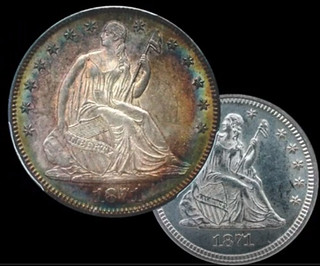 In December 2019, a client of rare coin dealer Gerry Fortin reported a shipment missing in the U.S. mail. Two coins
were in the package, an 1871 Liberty Seated quarter (NGC MS62) and an 1871 half dollar (PCGS MS62 / CAC). Fortin made inquiries with dealers in the delivery area, including Julian
Liedman, and within a couple weeks a connection was made.
In December 2019, a client of rare coin dealer Gerry Fortin reported a shipment missing in the U.S. mail. Two coins
were in the package, an 1871 Liberty Seated quarter (NGC MS62) and an 1871 half dollar (PCGS MS62 / CAC). Fortin made inquiries with dealers in the delivery area, including Julian
Liedman, and within a couple weeks a connection was made.
Lianna Spurrier tells the story of what happened next in this video recently released by Newman Portal. Newman Portal acknowledges Julian Liedman and Gerry Fortin for their contributions to this video.
Image: 1871 Liberty Seated quarter (NGC MS62) and 1871 half dollar (PCGS MS62 / CAC) that went missing in the U.S. mail.
Link to Detour: Coins that Revealed a Crime Ring on Newman Portal:
https://nnp.wustl.edu/library/book/581061
VIDEO: STUDENT ERIC LINDHOLM INTERVIEWED
These are selections from the David Lisot Video Library that feature news and personalities from the world of coin collecting. David has been attending coin conventions since
1972 and began videotaping in 1985. The Newman Numismatic Portal now lists all David's videos on their website at:
https://nnp.wustl.edu/library/multimediadetail/522852
Here's an interview with student Eric Lindholm. -Editor
 College Student Buys Cool
Indian Cent Variety at Long Beach Expo.
College Student Buys Cool
Indian Cent Variety at Long Beach Expo.
VIDEO: 3:47.
Eric Lindholm, Owner, Coin Scope, David Lisot, Interviewer, CoinTelevision.com.
Eric Lindholm flew out from Boston between his college classes to go the Long Beach Expo for the first time. Hear his perspective of the convention and learn about a cool variety of and 1868 Indian Cent.
An excerpt of the video is available for viewing on the Coin Television YouTube Channel at:
https://youtu.be/EBphkI37TY8
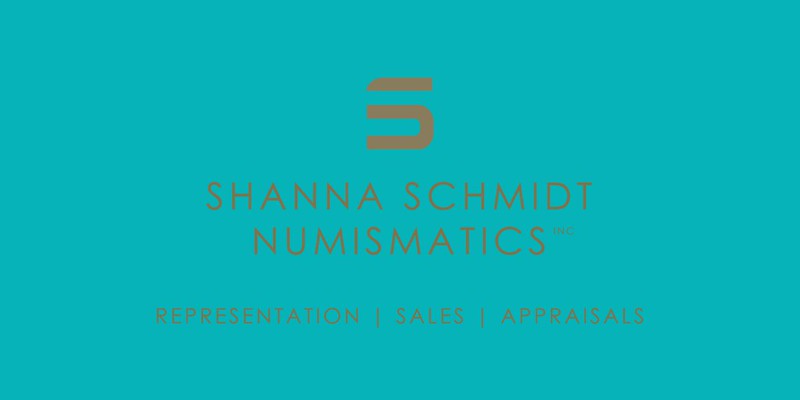
APRIL FOOLS 2020
Being shut in for a pandemic is no reason not to have a little fun. Maybe it's the best reason of all. It didn't take our readers long to spot the fake news items in last week's issue. -Editor

Progressional Coin Grading Service Working in Tandem With Robot
Dave Lange of Numismatic Guaranty Corporation writes:
"I got a kick out of this year's installment of the annual April Fool's Day joke. Everyone knows that if the U. S. Mint were to have its coins slabbed onsite it would be done by NGC!"
Kellen Hoard writes:
"Two articles stood out to me as I was reading through The E-Sylum. The U.S. Mint/PCGS one had me at first until I looked more closely. As for the 1913 nickel story, I applaud the heightened production value for the gag."
Steve Shupe writes:
"You had me going with the PCGS in the mint article but the air puff and Lincoln cents part threw it over the top."
Bill Eckberg writes:
"I assume you did notice the "April fool" at the end and were just pulling our “wooden” leg?"
The article on NGC slabbing 10 million Silver Eagles was a real item that I hadn't managed to get into an earlier issue. But it made a perfect foil and lead-in to my April Fools story about the "Progressional" Coin Grading Service deal with the U.S. Mint to slab coins right off of the presses.
The "St. Louis TV Station news video" about missing 1913 Liberty nickels was something the Newman Numismatic Portal had been planning for a while. We brainstormed a few ideas and came up with the concept of finding coins hidden in Col. Green's old wooden leg. NNP video consultant Lianna Spurrier ran with it and did a great star turn as a news anchor. Is the Today show in her future? -Editor
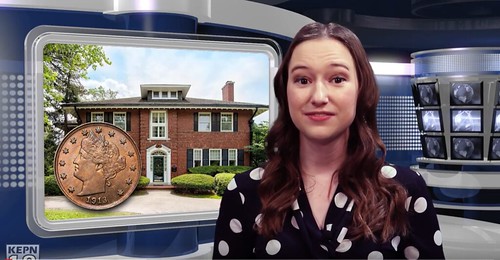
"Kaz" on the PCGS Discussion Board writes:
"Great gag! Reeled me in like a fish."
Pat McBride writes:
"Kudos to Lianna for “getting a leg up” on this story before the rest of the numismatic press."
ANA Edition reader Lev Messick writes:
"I do believe that that that young lady got us all for April Fool's Day! A little humor is a good thing for this current time."
Len Augsburger writes:
"Stu Levine said he nearly fell over laughing."
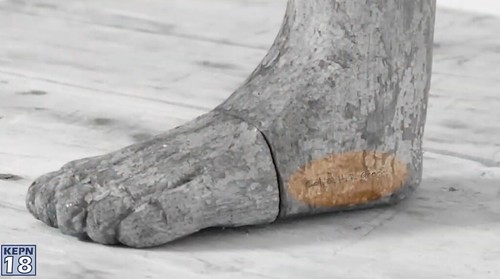
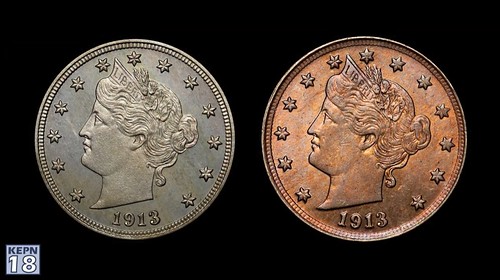

Bill Eckberg writes:
"REALLY good satire. It has more than enough truth to make it believable at first. I couldn't read the title on the grading submission sheet. It wasn't PCGS or NGC. And who is the coin dealer?"
Lianna Spurrier writes:
"The grading company is the entirely fictional "Numismatic Authentication & Evaluation Service," and the "coin dealer" is a friend of mine who volunteered that's not in the coin industry at all. I had a Joseph J. Fartelot Jr. arranged, but then all the closures hit from the coronavirus and he backed out. For what it's worth, the Fartelot truck was also entirely faked, and Lowen & Hopp doesn't exist. The 1913 nickels and wadded up bills are also fake, but I'm guessing we all realized those, and of course the inscription on the wooden leg photo. I had quite a good time putting this one together and trying to make it as believable as possible. If you look closely, the two 1913 nickels are entirely different coins (not just the same one with the color changed), and neither are actual 1913s - didn't want any specialists to be able to ID which specimen they were.
Glad people are enjoying it!"
Len Augsburger adds:
"Lowen & Hopp is based on the legal firm Lowenhaupt, for whom Eric Newman worked in the 1930s as an attorney."
Here's the direct link to YouTube:
Wooden Leg Sets St. Louis Legal Community on Fire
(https://www.youtube.com/watch?v=rUDSACJzzOE&feature=youtu.be)
Here's the article: LOOSE CHANGE: MARCH 29, 2020 : Missing 1913 Liberty Nickels Located? (https://www.coinbooks.org/v23/esylum_v23n13a35.html)
To read the PCGS discussion board, see:
Crazy discovery in St Louis!
(https://forums.collectors.com/discussion/1035352/crazy-discovery-in-st-louis#latest)
The video is well worth watching and rewatching.
There was one more article you had to read close to catch. -Editor
Bob Van Arsdell writes:
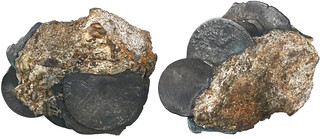 "I'm completely chuffed by the
article about medieval sixpences. It's one of the most thoroughly researched pieces in numismatics I've ever seen. I'm somewhat surprised, however, that the author didn't solicit
the opinion of the National Museum of Rutland - since it's right here in Vermont!"
"I'm completely chuffed by the
article about medieval sixpences. It's one of the most thoroughly researched pieces in numismatics I've ever seen. I'm somewhat surprised, however, that the author didn't solicit
the opinion of the National Museum of Rutland - since it's right here in Vermont!"
David Pickup supplied the text, and I added an image I found in an old Sedwick auction.
The articles on other collectibles might have looked fishy, but they're real. People really do collect and study pull tabs and banana labels. Here are a couple numismatic connections to the latter. -Editor
John Phipps writes:
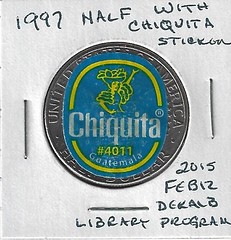 "I was very interested to
read in The E-Sylum the item on "Collecting Banana Labels." In February of 2015, I presented a "knowledge share" program on "Coin Collecting as a
Hobby" at the Dekalb County Public Library. Many people attend these programs on their lunch period so I took a lunch too. In the Q & A period I was facing the usual
questions. To make the point that rarity does not demand a higher price, I put a Chiquita sticker from the banana in my lunch on a 1997P Kennedy half dollar I had with me. Then I
said, "This is so rare it is the only one in the world, did the value go up?" When I got home I put the "rarity" in a 2x2 and added it to my
collection."
"I was very interested to
read in The E-Sylum the item on "Collecting Banana Labels." In February of 2015, I presented a "knowledge share" program on "Coin Collecting as a
Hobby" at the Dekalb County Public Library. Many people attend these programs on their lunch period so I took a lunch too. In the Q & A period I was facing the usual
questions. To make the point that rarity does not demand a higher price, I put a Chiquita sticker from the banana in my lunch on a 1997P Kennedy half dollar I had with me. Then I
said, "This is so rare it is the only one in the world, did the value go up?" When I got home I put the "rarity" in a 2x2 and added it to my
collection."
Good point, although advertising stickers on silver dollars and other coins are indeed collected and bring a small premium over the coin's silver value. And for a whopper of a value-added banana label, Jonathan Brecher reminds us of an item we discussed back in 2006. Thanks! -Editor
Jonathan writes:
"If you're going to mention banana labels, you really should include a reference to their most famous (?) numismatic cross-over."
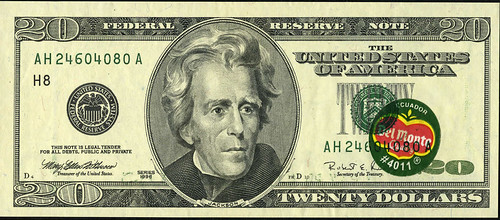
This colorful error is commonly referred by collectors in the numismatic fraternity as "The Del Monte Note," simply because of the banana sticker that is a retained printed obstruction. Most obstructions fall off shortly after printing leaving a blank area of paper missing the design, but errors with objects that "stick" to the note are very rare. Objects seen on other obstruction errors include a Band-Aid, paper fragments, scotch tape, and wood shavings. United States Currency is essentially printed in three stages: the first printing is the back of the note, the second printing provides the face devices, and the third, final printing includes the Treasury Seal and the serial numbers. When this note was printed at the Fort Worth facility of the Bureau of Engraving and Printing, it went through first and second printings before the sticker found its way onto the surface. The sticker's placement is ideal, as it covers part of the second printing details and is overlaid by part of the Treasury Seal and serial number from the third printing.
Most would conjecture that this note was no accident and probably the result of some very bored or creative BEP employee. Its presence in the market place however is not dubious as it passed through the regular channels of the Federal Reserve before it was released in circulation. In the summer of 2004 a college student in Ohio received it as part of an ATM withdrawal and shortly there after posted it on eBay where it sold to the highest of 12 bids. The note was a bargain at around $10,000 on eBay as news of the note had barely hit the collecting community. In subsequent weeks it was the cover story in Bank Note Reporter and Numismatic News.
To read the earlier E-Sylum article, see:
DEL MONTE BANANA LABEL ERROR NOTE SELLS FOR $25,300 (https://www.coinbooks.org/esylum_v09n02a05.html)
To read the complete lot description, see:
Fr.
2084-H $20 1996 Federal Reserve Note. PCGS Choice New 63PPQ. This colorful error is commonly referred by collectors in t...
(https://currency.ha.com/itm/error-notes/fr-2084-h-20-1996-federal-reserve-note-pcgs-choice-new-63ppq-this-colorful-error-is-commonly-referred-by-collectors-in-t/a/396-16409.s)
Here are some non-numismatic April Fool stories from the Hyperallergic blog, including "Museum of the Bible Reveals Newly Discovered Audio Recording of the Sermon on the
Mount.":
Hyperallergic blog April 1, 2020 . -Editor
To read the earlier E-Sylum articles, see:
FOOL: NOTES FROM E-SYLUM READERS: MARCH 29, 2020 : Medieval Silver Sixpences Found in a Pudding
(https://www.coinbooks.org/v23/esylum_v23n13a19.html)
REAL: NGC CERTIFIES 10,000,000 SILVER EAGLES (https://www.coinbooks.org/v23/esylum_v23n13a23.html)
FOOL: U.S. MINT AUTOMATES SLABBING WITH PARTNERSHIP (https://www.coinbooks.org/v23/esylum_v23n13a24.html)
REAL: PULL TAB ARCHEOLOGY (https://www.coinbooks.org/v23/esylum_v23n13a36.html)
REAL: COLLECTING BANANA LABELS (https://www.coinbooks.org/v23/esylum_v23n13a37.html)
FOOL: LOOSE CHANGE: MARCH 29, 2020 : Missing 1913 Liberty Nickels Located?
(https://www.coinbooks.org/v23/esylum_v23n13a35.html)
THE ANA CONVENTION THAT WASN'T: 1918
A century ago another deadly pandemic ravaged the world - the Spanish flu of 1918. Len Augsburger of the Newman Numismatic Portal submitted this report on the cancelled American Numismatic Association convention of that year, and asks for help locating a copy of the rare unofficial convention photograph. -Editor
The Convention That Wasn't, and a Rare Photograph
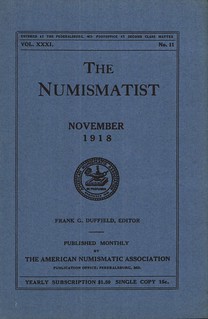 Imagine you arrived at the ANA
convention and everyone else had gone home or stayed there to begin with. This is precisely what happened in Philadelphia in October 1918. Cancelled at the last minute, a number
of attendees arrived in a city shut down by the Spanish flu. The best account is given by Philadelphia dealer and convention chairman S. H. Chapman, who reported in the November
1918 Numismatist that the convention, scheduled for October 5-9, was cancelled by the city on October 3. Chapman did his best to notify attendees, who might have numbered
around a hundred. Some could not be reached in time, and a small group arrived in Philadelphia expecting a convention.
Imagine you arrived at the ANA
convention and everyone else had gone home or stayed there to begin with. This is precisely what happened in Philadelphia in October 1918. Cancelled at the last minute, a number
of attendees arrived in a city shut down by the Spanish flu. The best account is given by Philadelphia dealer and convention chairman S. H. Chapman, who reported in the November
1918 Numismatist that the convention, scheduled for October 5-9, was cancelled by the city on October 3. Chapman did his best to notify attendees, who might have numbered
around a hundred. Some could not be reached in time, and a small group arrived in Philadelphia expecting a convention.
Attendees made the best of a bad thing, and Chapman reported small social gatherings at the convention hotel. The tradition of a convention photograph was continued. Included in the photo were the Chapman brothers of Philadelphia, Mr. and Mrs. Howard R. Newcomb, and a handful of others, about a dozen total. A few of the attendees likely attended S. H. Chapman's sale of the H. O. Granberg collection, which took place as scheduled, despite the Board of Health warning against “public assemblages.” Presumably many of the bids had already been received by mail.
The Rochester Numismatic Association minutes for October 15, 1918 reported “[ANA] President H. H. Yawger then told the members about his recent trip to Philadelphia, he having visited that city at the time that had been set for the American Numismatic Convention but which was called off on account of the influenza epidemic. Mr. Yawger had a most delightful time visiting with the Philadelphia Numismatists, and while there, also met with a number of A.N.A. members from different cities, who had not been notified of the postponement of the Convention until after they had started on their journey, and they all met at the Hotel Stenton and had a good talk on numismatic matters, the meeting ending up by their having their photographs taken in a group...Yawger was most enthusiastic in his account of the delightful time he spent at the homes of Mr. Henry Chapman and Mr. S. H. Chapman...”
The convention photograph was not published in The Numismatist, and the only example we could find appeared in the George Kolbe #91 sale, 6/2003, lot 670, there described as “sepia photograph; approximately 10 x 15.5cm.” Taking ANA convention photographs usually required a wide-angle lens, but the photographer's job was considerably simplified in 1918. Can an E-Sylum reader provide an image?
Thanks! Great story and a great parallel to today. Does anyone have a copy of the 1918 Philadelphia ANA convention photo? -Editor
Link to The Numismatist on the ANA site:
https://www.money.org/subscriber-all-access
Link to The Numismatist on Newman Portal: https://nnp.wustl.edu/library/publisherdetail/510969
Link to the Rochester Numismatic Association minutes on NNP: https://nnp.wustl.edu/library/book/511995
QUERY: 1912 CHAPMAN EARLE SALE PHOTO CAPTION
On a related note, Tony Terranova submitted this photo of bidders at the 1912 Chapman sale of the George H. Earle collection, held in Philadelphia June 25-29, 1912. He writes: "Some cast of characters!! People should have fun seeing how many faces they can identify". Is anyone game? It's a big batch of bidders! -Editor
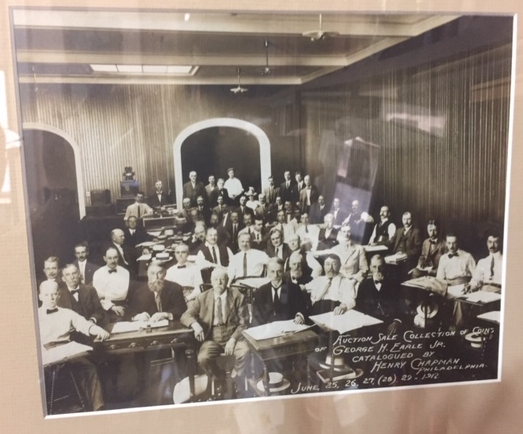
The photo was lot 1144 in the March 1995 Bowers and Merena Armand Champa Library Part II sale. Here's the lot description, which provides names of some of the attendees. -Editor
[Henry Chapman]: [Photograph of "Auction Sale Collection of Coins of George H. Earle,June 25, 26, 27, (28), 29 - 1912" Fine black and white photograph, 19/2x24cm, handsomely matted in a cherry frame. (400.00)
A rare period glimpse of the attendees assembled for what was to set records as the single largest day ($23,522) and largest total gross ($55,821) coin sale in the United States, this held at the art gallery of Davis & Harvey, 901 Walnut St, Philadelphia. Prominent participants include both Chapmans, Thomas Elder, Elmer Sears, Edgar Adams, Farran Zerbe, and Edgar Adams. This photograph is reproduced on the front endsheets of John Adams' work on 19th-century auction catalogues. From the Chapman estate, Wayte Raymond and John Ford.
To read the catalog on the Newman Numismatic Portal, see:
The Armand Champa Library: Part II
(https://nnp.wustl.edu/library/auctionlots?AucCoId=4&AuctionId=525058)
KENT PONTERIO ON THE STATE OF THE MARKET
Joe Lang of Stephen Album Rare Coins writes:
"Here is the text of the latest World Numismatics Newsletter from Kent Ponterio about the state of the market. I found it very enlightening and thought it might be worth publishing…"
Thanks. With permission, we're republishing the complete letter here. -Editor
 We at World Numismatics have been
working diligently to update our website with new inventory available for direct sale to our clients. In lieu of the current situation and the absence of coin shows for the
foreseeable future, more of our stock will be filtered through our website and updates will be happening on a more consistent basis.
We at World Numismatics have been
working diligently to update our website with new inventory available for direct sale to our clients. In lieu of the current situation and the absence of coin shows for the
foreseeable future, more of our stock will be filtered through our website and updates will be happening on a more consistent basis.
Our take on the current state of the market:
Let me preface this with a little background. Prior to the COVID-19 outbreak in the United States, Patrick Richey and I were traveling abroad in Europe attending auctions,
visiting dealer contacts and planned to attend the Munich Coin Fair (which wound up being cancelled). After the coin fair was cancelled, Patrick and I made the decision to return
home as it had become clear to us that things had begun to escalate in Europe as well as in the United States. Flights were being cancelled at an alarming level as well as travel
bans being put in place, and we were concerned about our ability to return to the US. We cancelled the last segment of our trip and were able to reschedule a flight home on March
10th.
It was a strange and awkward decision, but in the end, I am convinced it was the right one.
Sure enough, within days of our return travel restrictions were put in place limiting international flights.
We visited 6 countries while in the EU. Our first stop was Spain which at the time had fewer than 100 confirmed cases of COVID-19. During the next few days in Europe, we watched the number grow exponentially and decided to cut our trip short. While on our trip it was clear that things were very different than normal in terms of buying coins.
Although we were able to acquire many new items for inventory, it was much harder to buy interesting coins than previous trips. Many of our contacts in major cities told us similar stories to the effect of “normally in Europe when someone has coins to sell, they travel to the cities to sell coins to the major dealers”. This simply wasn't happening and had not been happening for some time, nor do I see this returning to the way it was any time soon. Hence the normal dealers from which we buy nice coins simply did not have a lot to sell. Couple that with the inability to ship coins out of certain countries due to nation-wide lock downs and the supply issue becomes very clear. The supply of new coins to the marketplace here in the U.S. is going to be rather limited for the unforeseeable future.
What does the future hold for the coin market?
To be perfectly honest, I have no idea. At the moment we are like Magellan circumnavigating uncharted waters and we will see where our voyage takes us. What I can share with you
is my firsthand experiences and observations of what's transpiring in the coin market since this all started.
Thus far the coin market seems to remain fairly resilient, all things considered. Some aspects of the market may even be stronger now than they were a few months ago. For example, the premiums on generic gold and silver bullion have increased significantly. Auction sales for numismatic coins have also been very strong as of late. This started with the Gorny and Mosch auction while Patrick and I were still in Europe, which yielded very high results. Other auctions, like Kunker in Germany and ROMA in the United Kingdom, were intended to be floor auctions, but wound up being internet sales due to restrictions on public gatherings and were also remarkably strong. This trend continued with CNGs electronic auction bringing well above expectations, but perhaps the real testament were the prices achieved by Stacks Bowers. With the last-minute cancelation of the Whitman EXPO in Baltimore and restrictions on public gatherings, Stacks Bowers was forced to conduct their auction using internet and phone bidding only. After witnessing the results they yielded, I am convinced they achieved better prices than they would have during normal circumstances.
So what does this all mean? Once again, I'm not really sure. What I can tell you is that since we have been back, we have been flooded with phone calls and emails from people wanting to buy coins.
Are people bored and stuck at home looking for new coins for their collections? I suppose that's one plausible explanation. During the lock downs in China, the Chinese coin market prospered and prices on many items actually went up in value. Simply stated, collectors were bored and sat at home examining their collections while scouring the internet looking for new acquisitions. I think that is only one factor, and there's more to it than that. There are also those who are looking to put money into something more portable and of value. Many have taken money out of the stock market, while others are fearing hyperinflation. Whatever the reason, right now people want to buy coins.
Leading up to this event dealers' inventories were rather depleted, and it was really hard to find nice coins at coin shows. Couple that with the inability to attend coin shows or auction for the foreseeable future, as well as the problems importing coins from abroad. I predict we are going to have a real shortage of good coins available in the marketplace. This dilemma is not going to correct itself overnight. Furthermore, when the world opens back up, a supply of nice coins will not magically appear. These things take time, and it will take time for dealers to replenish their stocks. It will be a slow gradual reboot rather than everybody opening back up for business.
Trade shows will probably be one of the last things to open back up, and this is going to be hard for a lot of us in the industry. Coin shows fall under that category of “large gatherings” and frankly I think it will take some time for them to return to normal. Certainly, the industry was already moving in a direction of online sales and had been for some time. Current events just gave it a swift push further in that direction.
What's important right now?
I would love to tell you that buying coins is important right now, but it is not. In the coming weeks and months, many of us will have much more free time than we are accustomed
to. Those of you that are with your loved ones, hold them close. Those of you that are not, call them, text them photos, send them emails. I think right now it is important to
reach out to loved ones as not everyone will fair this situation the same. That said, if you love coins and want to add something to your collection, by all means do so. Our
hobbies are our passions and are a great tool for helping one maintain his sanity in trying times. When I say that, I'm not just saying buy something from our website. There are a
lot of dealers that will struggle in the current market. Some will have to reinvent themselves. Some made their livings primarily from traveling the coin show circuits. The
inevitable truth is that we may lose some coin dealers as a result. Many of these people are our friends, people we see at every coin show and have for decades. One of my fears is
that when coin shows commence again, we may not see some of these faces. For lack of a better term, some of the “mom and pop” coin dealers will struggle.
If you have the opportunity, take some time to spend a little money with some of the smaller coin dealers.
Anyhow, I will do my best to post updates on the site as time goes on. As coins come back from grading, they will continue to go up on the website. Several packages of new coins are in-bound from abroad and will be uploaded once graded. My hope is to continue to offer new coins for collectors on a regular basis during all of this.
Thanks for listening to me rant. If you find something on the site you're interested in, please send us an email with any questions.
If you have any rare coins or are thinking of selling your collection, please reach out to us.
We are actively buying and paying very competitive prices for high grade and rare coins.
I hope to see you at a coin show at some point in the future when things return to the new normal.
Stay safe and stay healthy.
Kent Ponterio
World Numismatics, LLC.
To visit the World Numismatics web site, see:
https://worldnumismatics.com/
CORONAVIRUS UPDATES: APRIL 5, 2020
Here's another compilation of updates from readers and companies. Some of these came to me before our last issue and I didn't get a chance to include them last time. The situation changes rapidly, so some of these may be outdated by the time you see them, but they provide a great snapshot of where things are in the hobby today. -Editor
Canadian Coin News (March 24, 2020)
Mike Walsh of Trajan Publishing Corporation writes:
 "As long as the printing presses
remain operating and Canada Post continues delivering mail, we will continue to publish Canadian Coin News and Canadian Stamp News. This is possible in large part to
our employees, who are working from home in accordance with recommendations from public health officials. I want to thank Laury, Penny, Jim and Jesse for all their hard work and
commitment during this challenging time. I also want to give a huge thank you to our columnists and advertisers for their support.
"As long as the printing presses
remain operating and Canada Post continues delivering mail, we will continue to publish Canadian Coin News and Canadian Stamp News. This is possible in large part to
our employees, who are working from home in accordance with recommendations from public health officials. I want to thank Laury, Penny, Jim and Jesse for all their hard work and
commitment during this challenging time. I also want to give a huge thank you to our columnists and advertisers for their support.
Because Canada Post has shortened post office hours for cleaning and restocking, you may experience delays in receiving your print editions of CCN or CSN. To minimize these potential delays, we're offering all print subscribers complimentary access to our digital editions throughout the COVID-19 outbreak"
Pobjoy Mint, England (March 25, 2020)
The Pobjoy Team writes:
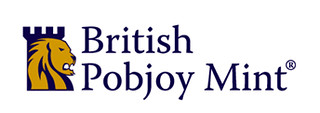 "Following on from recent
Government Announcements, our office is now completely closed!
"Following on from recent
Government Announcements, our office is now completely closed!
"This, unfortunately, means we will no longer be able to process or send any orders out until the office is open again. We will still be responding to emails and Facebook messages, however, please be aware, that this will be more delayed than usual whilst our staff remain home during these tough times.
"Any orders currently on a pre-order release date are now unfortunately delayed until further notice. We can only apologise this has happened but unfortunately this is outside of our control and we must follow in line with the Government's advice."
Ira & Larry Goldberg Coins and Collectibles (March 25, 2020)
Ira and Larry Goldberg write:
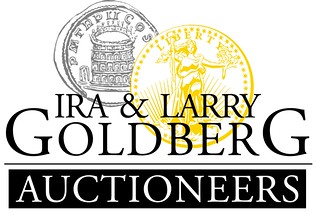 "The numismatic and bullion markets remain
consistent and strong. Should you need to transfer into bullion or cash, we are here to serve you.
"The numismatic and bullion markets remain
consistent and strong. Should you need to transfer into bullion or cash, we are here to serve you.
"On March 21-23 we concluded our semi-annual Collectibles Auction, and by adapting to a last minute e-mail and phone bidding platform, we had one of our most successful auctions. People have more time to spend on their hobbies which was proven by the record number of on-line and phone bidders setting solid prices realized for jewelry, historic manuscripts, space related items, high end collectibles, and stamps.
"We will therefore gladly help clients buy or sell gold and silver bullion, appraise rare coins and currency and accept consignments for our upcoming June 1-3, 2020 Pre Long Beach Expo (with or without the expo)"
Kagin's, Tiburon, CA (March 26, 2020)
Don & Candace Kagin and the Kagin's Staff write:
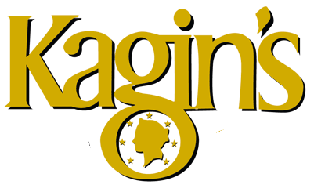 "We recognize that numismatics is not “essential”, but
commerce is and we wish to do our small part in keeping our economy functioning.
"We recognize that numismatics is not “essential”, but
commerce is and we wish to do our small part in keeping our economy functioning.
"Today, former Soviet prisoner (nine years - with half in solitary confinement for “Zionist activities”) and Israeli politician, Natan Sharansky offered five tips to get through this quarantine situation. Number four was “don't give up your hobby.”
"Indeed, our non-essential endeavor may seem inconsequential during these difficult times, but it can be therapeutic to focus on something that gives each of us some degree of purpose, challenge and satisfaction.
"To the extent that we can, Kagin's will be providing new coins and currency inventory on our web site and answering our telephones concerning your needs. We look forward to hearing from you."
Spink, London
The Spink Banknotes Team writes:
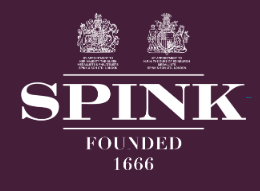 "Spink still intend to hold closed door
auctions for the Professor Hsu, World Banknotes and Bank of England Charity Auction. COVID-19 has affected us all and the global state of affairs is changing daily but we believe
it is important that life carries on wherever possible and collectors will, I am sure, welcome a form of escape from the situation. Spink has recently held philatelic and
numismatic auctions behind closed doors and the response has been amazing. This clearly shows that collectors appreciate and welcome the opportunity to participate in the hobbies
they love.
"Spink still intend to hold closed door
auctions for the Professor Hsu, World Banknotes and Bank of England Charity Auction. COVID-19 has affected us all and the global state of affairs is changing daily but we believe
it is important that life carries on wherever possible and collectors will, I am sure, welcome a form of escape from the situation. Spink has recently held philatelic and
numismatic auctions behind closed doors and the response has been amazing. This clearly shows that collectors appreciate and welcome the opportunity to participate in the hobbies
they love.
"Spink will be constantly monitoring the situation and Government advice; the safety of our staff is of paramount importance and updates will be forthcoming. In the meantime, keep well and safe and let us hope for an exciting series of auctions.
"We have every confidence in our online auction platform, Spink Live, which is widely and rightly acclaimed by collectors worldwide. Bidders are also welcome, as always, to leave bids with us prior to the auction or to arrange a phone-bid."
Douglas Saville, Reading, England

Douglas Saville writes:
"We are doing ok- my office is 5 minutes drive from our home- I go in there a couple of times a week to check on post etc- basically it is quiet- and I am dealing with a few emails each day. "
To visit Doug's website of numismatic literature, see:
https://www.douglassaville.com/
Dix Noonan Webb, London (March 30, 2020)
Dix Noonan Webb writes (in a press release):
 "As Chairman & CEO, Pierce Noonan explains:
“In the last three weeks we have noted unprecedented levels of activity on our website, a trend we expect to continue over the months ahead. We anticipate that during this period
many collectors will have more time to spend on their hobbies than usual, and it is therefore our intention, with the aid of our tried and tested online technology to step things
up a gear and host more auctions than ever before. DNW's auctions will continue to be run in the conventional manner with one of our expert auctioneers controlling the sale and we
hope these will prove a source of interest and pleasure to our clients throughout this difficult period.”
"As Chairman & CEO, Pierce Noonan explains:
“In the last three weeks we have noted unprecedented levels of activity on our website, a trend we expect to continue over the months ahead. We anticipate that during this period
many collectors will have more time to spend on their hobbies than usual, and it is therefore our intention, with the aid of our tried and tested online technology to step things
up a gear and host more auctions than ever before. DNW's auctions will continue to be run in the conventional manner with one of our expert auctioneers controlling the sale and we
hope these will prove a source of interest and pleasure to our clients throughout this difficult period.”
"All of DNW's online capabilities have been developed in-house and are therefore completely within their control. However, what is not within their control is the production of printed catalogues and their subsequent delivery across the world. For this reason they will temporarily cease production of printed catalogues for the majority of their auctions. Their electronic catalogues will all be presented to the highest standard and available free of charge - downloadable and printable by anyone in an instant, with high definition images of every lot offered being available on our website as usual.
"Contingencies have been put in place to deal with a variety of scenarios and all staff are equipped with laptops to enable them to work remotely from any location. In line with government advice their Mayfair office is currently staffed by essential workers only. In all eventualities the vast majority of DNW staff will be working and fully contactable by phone and email during normal office hours. Phone calls made to a member of staff's direct landline will seamlessly divert to their mobile phones when they are not in the London office and the main telephone switchboard will continue to operate as usual."
Jeff Rock, San Diego, CA (March 31, 2020)
Jeff writes:
"It's definitely a weird time to live through - hopefully as close as we come to knowing what the Spanish flu pandemic was like a century ago (though with far, far fewer deaths, fingers crossed). But I think we are all getting used to a new norm. More time at home means more time with the hobby - I'm finishing up a 100 page article for the Journal of Early American Numismatics, going through my Conder token collection and adding edge information to every photograph (finding misattributions and a couple new varieties along the way), working on evasion copper die pairing and really spending more time studying the things in my collections a lot more, some of them pieces i hadn't looked at once since acquiring them. It seems odd that something that used to be normal - running to the Post Office, bank, a couple of grocery stores - is now fraught with danger and instead of doing them at leisure, enjoying the day, now one rushes through them to get back to the safety of home. This self isolation might get unbearable as the weather warms up and all we do is gaze out the windows at the sunny day outside!
"Stay safe - and thanks again for providing something wonderful to read each week, even though I am a couple weeks behind. Right now we all need things to occupy our brains, and this email is looked for to more than ever."
Numismatic Guaranty Corporation, Sarasota, FL (March 30, 2020)
David Lange of NGC writes:
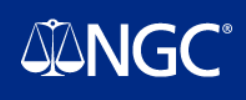 "NGC and the other companies of Certified
Collectibles Group are still fully operational. Florida has not issued a stay-at-home order, and business goes on as usual, with just a few adjustments. My job was judged to be
one that does not require a daily presence at the office, so I'm working from home three days a week. I still go into the office on Tuesdays and Thursdays to perform my
authentication and variety attribution chores which, not surprisingly, can't be done without actually seeing the coins!"
"NGC and the other companies of Certified
Collectibles Group are still fully operational. Florida has not issued a stay-at-home order, and business goes on as usual, with just a few adjustments. My job was judged to be
one that does not require a daily presence at the office, so I'm working from home three days a week. I still go into the office on Tuesdays and Thursdays to perform my
authentication and variety attribution chores which, not surprisingly, can't be done without actually seeing the coins!"
Dave adds (April 2, 2020):
"Florida's governor has declared a stay-at-home order to be effective at midnight. CCG management is keeping the company open until further notice, citing an exclusion clause in the executive order."
To read the complete press release, see:
NGC and PMG Remain Open and Fully Operational (https://www.ngccoin.com/news/article/8187/)
Certified Acceptance Corporation (CAC), Far Hills, NJ (April 1, 2020)
The CAC Team writes:
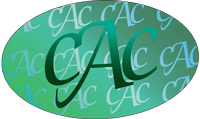 "To slow the community spread of COVID-19
and for the welfare of our employees, Certified Acceptance Corporation (CAC) has decided to close its operation effective April 1, 2020. We will tentatively re-open on Wednesday,
April 15 subject to current conditions. Customers are asked not to send submissions to our office until further notice. If you have already sent submissions to our office, your
packages will be accepted and stored securely in our office. If your submissions are currently at our office, they will be held at the office and stored securely. We are sorry for
this inconvenience. This is an ever-changing situation and we will provide updates on our CAC website at www.caccoin.com.
"To slow the community spread of COVID-19
and for the welfare of our employees, Certified Acceptance Corporation (CAC) has decided to close its operation effective April 1, 2020. We will tentatively re-open on Wednesday,
April 15 subject to current conditions. Customers are asked not to send submissions to our office until further notice. If you have already sent submissions to our office, your
packages will be accepted and stored securely in our office. If your submissions are currently at our office, they will be held at the office and stored securely. We are sorry for
this inconvenience. This is an ever-changing situation and we will provide updates on our CAC website at www.caccoin.com.
"Our thoughts are with everyone at this difficult time and we hope that we can soon provide our valuable services to our members."
Legend Rare Coin Auctions, Lincroft, NJ (April 1, 2020)
Legend writes (in a Press Release):
 "With the uncertainty and chaos that the
current Covid-19 global pandemic is bringing to the markets and people's everyday lives, numismatics seems to be providing a safe haven and comfort to collectors all over. Legend
Rare Coin Auctions' 37th Regency Auction was scheduled to take place at Le Meridien in Philadelphia. Two weeks prior to the sale, with various orders from different entities,
federal, state, and local, Legend made the decision to hold the auction in the firm's New Jersey offices, as a live, webcast only auction, with no floor bidders. Unsure how the
situation would play out, email reminders were sent out daily to bidders. Every effort was made to ensure that people who could not come to the office to view to see the coins as
close to in hand as possible. Thanks to modern technology, text messaging videos or utilizing Facetime, this is easier now than ever before. In the end, these efforts paid off, as
a record number of online bidders registered to participate in the auction. This proved, yet again, that the demand for rare coins from collectors is deep, and despite the
uncertain times, this demand can be insatiable when the coins are fresh and high quality.
"With the uncertainty and chaos that the
current Covid-19 global pandemic is bringing to the markets and people's everyday lives, numismatics seems to be providing a safe haven and comfort to collectors all over. Legend
Rare Coin Auctions' 37th Regency Auction was scheduled to take place at Le Meridien in Philadelphia. Two weeks prior to the sale, with various orders from different entities,
federal, state, and local, Legend made the decision to hold the auction in the firm's New Jersey offices, as a live, webcast only auction, with no floor bidders. Unsure how the
situation would play out, email reminders were sent out daily to bidders. Every effort was made to ensure that people who could not come to the office to view to see the coins as
close to in hand as possible. Thanks to modern technology, text messaging videos or utilizing Facetime, this is easier now than ever before. In the end, these efforts paid off, as
a record number of online bidders registered to participate in the auction. This proved, yet again, that the demand for rare coins from collectors is deep, and despite the
uncertain times, this demand can be insatiable when the coins are fresh and high quality.
"Anchoring the auction was the extensive Seattle Collection. Assembled by a very dedicated collector over the course of the last two decades, the Seattle Collection featured complete sets of Mint State two-cent, three-cent silvers, three-cent nickels, Liberty and Shield nickels, and related patterns. From the outset, bidding for these coins was intense, actively bid on by hundreds of different bidders from across the country. Strong prices were realized across the board, with the 1884 three-cent nickel graded PCGS MS66 CAC (lot 58) realizing a world record price of $42,300 and the 1870 Shield nickel, also graded PCGS MS66 CAC (lot 69), realizing a world record price of $10,281. All told, the Seattle Collection realized over $504,000.
“Numismatics is the world's greatest hobby!” exclaimed Legend Rare Coin Auctions' founder, Laura Sperber after the auction. “Even in times of global crisis, collectors find comfort in collecting. Paper assets, are just that,” she continued, “but tangible assets offer something more than just a store of value. From collector oriented series like the Seattle Collection to Pan-Pac $50 slugs, every area saw quite a bit of action!”"
Holabird Western Americana, Reno, NV
Regarding their upcoming sale, Holabird writes:
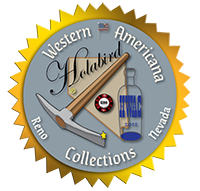 "Due to the global Covid-19
situation, this sale will be unique in that it will be conducted online only. Our Reno office will not be open for in-person attendees. However, we've noticed the same trend
as other auction houses that the vast majority of the bidding action is taking place online/over-the-phone anyway, so we are expecting a huge online turnout for this auction.
Login and join us remotely for a fabulous 4 days!
"Due to the global Covid-19
situation, this sale will be unique in that it will be conducted online only. Our Reno office will not be open for in-person attendees. However, we've noticed the same trend
as other auction houses that the vast majority of the bidding action is taking place online/over-the-phone anyway, so we are expecting a huge online turnout for this auction.
Login and join us remotely for a fabulous 4 days!
"As usual, we will be streaming live video and audio across the platforms and have phone operators standing by to assist with bidding and/or technical issues.
"For this sale, phone or video previews are strongly encouraged. Our staff is tech savvy and ready to use Skype/Facetime/Zoom etc. to video preview with you. Please provide a list of items and minimum of 24 hours notice so that we may pull your lots and schedule a private viewing. Office preview by special private appointment only. Call (775) 851-1859 to schedule."
Hong Kong May Coin Show Cancelled (April 2, 2020)
Hong Kong Coin Show Team writes:
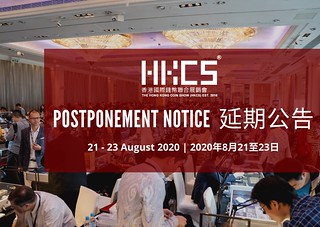 "As a valued
exhibitor/visitor of Hong Kong Coin Show, you are at the heart of our team. In the hope of the alleviation of the Coronavirus situation, we had postponed the event till May,
meanwhile closely monitoring the situation as it evolved. At this stage, the effects of Coronavirus are evident across the world, with burgeoning travel restrictions.
"As a valued
exhibitor/visitor of Hong Kong Coin Show, you are at the heart of our team. In the hope of the alleviation of the Coronavirus situation, we had postponed the event till May,
meanwhile closely monitoring the situation as it evolved. At this stage, the effects of Coronavirus are evident across the world, with burgeoning travel restrictions.
As per the announcement of Hong Kong SAR government on 17 March 2020, compulsory quarantine is required to people arriving in Hong Kong who have been to all overseas countries in the past 14 days. We also received a letter from Centre for Health Protection of Department of Health that organizers should cancel or defer mass event until the pandemic is settled. Consequently, we have made the incredibly difficult decision to cancel the May show. It is our full intention to host our August Show, currently scheduled for 21 - 23 August 2020. We will keep you informed of any new developments of the legal measures as we receive them.
"The team wishes that you and your family stay well and take very good care. We look forward to having travel return to normal and welcoming you again in our next show."
Heritage Auctions, Dallas, Texas (April 3, 2020)
Heritage writes:
 "We have heard from so many of our
partners, clients and friends. Many are wondering how our company is faring during this turbulent time, and we want to assure all of you that Heritage Auctions remains open for
business.
"We have heard from so many of our
partners, clients and friends. Many are wondering how our company is faring during this turbulent time, and we want to assure all of you that Heritage Auctions remains open for
business.
"All departments of Heritage's 40+ auction categories remain fully operational, and eager to accept quality collectibles, art and other valuable objects for upcoming auctions. Every Heritage specialist and consignment director is available by phone, email or video conference call.
"We have also seen a significant uptick in bidding activity, website visitors and prices realized in recent weeks. Heritage conducts 10-15 auctions every week. Even before 2020, virtually 100% of all winning bids had come from our registered online bidder-members. All of our auctions since mid-March have been conducted entirely online, and each has seen unusually strong results, significantly exceeding expectations that were set before this troubled present.
"Heritage has weathered many storms in the past and has always helped our clients weather them as well. Each time, we've emerged on the other side with strengthened relationships, serving more clients in new and better ways than ever before. We pledge and sincerely believe that this moment will be no different."
Ron Guth, San Diego, CA (April 2, 2020)
Ron writes:
"I've been working at home since 2008, so this is nothing new for me. Same with online sales...for the past two decades people have asked me where I've been doing most of my business...now they know and are experiencing it for themselves. I suspect this COVID-19 thing will change the numismatic market forever, even for the better."
CDN Publishing (Greysheet, Greensheet, and CPG Market Review)
In an email to readers, publisher John Feigenbaum writes:
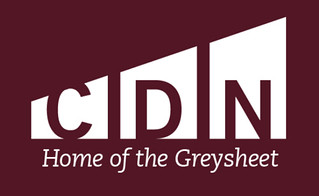 "As a life-long entrepreneur and
small business operator, I have faced down numerous existential challenges like the terrorist attacks on 9-11-2001 and the market crash of October 2008. Both events caused
precipitous changes in business and we had to react quickly. Neither was like the COVID-19 attack of 2020, and we still do not know how the economy and our basic way of life will
be affected by the current state of events.
"As a life-long entrepreneur and
small business operator, I have faced down numerous existential challenges like the terrorist attacks on 9-11-2001 and the market crash of October 2008. Both events caused
precipitous changes in business and we had to react quickly. Neither was like the COVID-19 attack of 2020, and we still do not know how the economy and our basic way of life will
be affected by the current state of events.
"The good news for us is CDN Publishing is OPEN for business. Our staff is safely working from home and one of us comes in daily to make sure orders are packed and shipped. We are working tirelessly to make sure prices are updated in this wild bullion market and to answer your phone calls for support and we are offering special discounts to help our subscribers stay on.
"Here at CDN Publishing, we are finding that the numismatic marketplace is resilient. Ironically, the characteristics of the dealers and collectors in our community are well suited to today's challenges. For example, most dealers only employ themselves and a few staff (or family) members. Collectors have become well accustomed to shopping online and bidding in internet-based auctions and the most successful companies have built their businesses around this model. With almost no lead time to prepare, Stack's Bowers was able to move their live auction across the country, protect their employees from unnecessary travel, and hold a very successful sale in their private offices. Heritage has already shifted their Central States Auction from Chicago to their office in Texas, and they likely will not see any negative effects from the transition because they have been building tremendous bidding software for decades now. Smaller firms like Great Collections, David Lawrence Rare Coins and Legend Auctions are equally prepared and all welcome your phone calls or emails to do business, as are the thousands of other dealers you will find in the CDN Dealer Directory.
"It's not all rosy, though. Small dealers will be hurt, to be sure. Most brick-and-mortar stores are now closed down until the virus passes and nearly all coin shows have been forced to cancel, or postpone. It's uncertain how they will fare under a prolonged shutdown.
"My advice to those who have built their businesses around shows is to use this time to embrace the internet and build your online presence."
As noted last week, crises have a way of accelerating the inevitable. The Wall Street Journal aptly summarized the situation. -Editor
The new coronavirus pandemic is deepening a national digital divide, amplifying gains for businesses that cater to customers online, while businesses reliant on more traditional models fight for survival.
The process is accelerating shifts already underway in parts of the U.S. economy in ways that could last long after the health crisis has passed, some analysts say.
“What we're in right now is a sudden and extreme version of what had been a much longer, slower-moving trend,” said Jed Kolko, chief economist at job site Indeed.
The big question, economists say, is whether the changes created by this sudden, forced experiment will prove permanent after the coronavirus pandemic eases. If so, that could transform the U.S. economy and open the way to new types of businesses and providers.
The pandemic is also fueling a shift to e-commerce in corners of the retail universe in which consumers have historically resisted going online, such as beauty products and groceries.
And the numismatic business? -Editor
To read the complete article (subscription required), see:
Coronavirus Pandemic Widens Divide Between Online,
Traditional Businesses (https://www.wsj.com/articles/coronavirus-pandemic-widens-divide-between-online-traditional-businesses-11585733402)
When No One is There to See the Art
I enjoyed this night-at-the-museum piece from the Washington Post (published March 25, 2020). -Editor
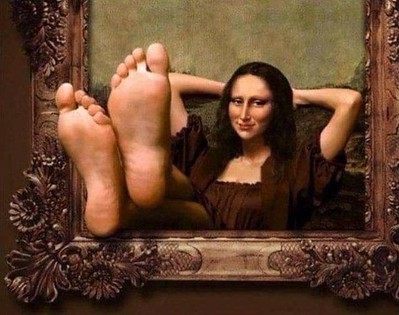
As art memes circulating in the age of coronavirus go, it is more whimsical than ominous. It shows the Mona Lisa, perhaps the most famous painting in the world, edited to present its subject at ease, reclining with her feet up. Her smile is unmistakably happy rather than enigmatic, and her feet are thrust out of the picture plane and right into our faces.
Although the image was created well before the current pandemic, as it bounces around again on Twitter, it seems as if she is having her “first vacation in 500 years,” as one user captioned it in a tweet.
The Louvre, like museums all around the world, is closed. The humor of the meme is its suggestion that the great, iconic works shuttered therein are letting us know how exhausted they were with our usual attention.
To read the complete article, see:
What
Mona Lisa with her feet up says about art after coronavirus
(https://www.washingtonpost.com/entertainment/museums/what-mona-lisa-with-her-feet-up-says-about-art-after-coronavirus/2020/03/24/b6409068-6dde-11ea-a3ec-70d7479d83f0_story.html)
To read the earlier E-Sylum article, see:
CORONAVIRUS UPDATES: MARCH 29, 2020 (https://www.coinbooks.org/v23/esylum_v23n13a15.html)

NOTES FROM E-SYLUM READERS: APRIL 5, 2020
Notes from Robert J. Leuver
It's always great to hear from E-Sylum readers and learn from their experiences. Bob Leuver was Director of the U.S. Bureau of Engraving and Printing and Executive Director of the American Numismatic Association. -Editor
Bob writes:
"As always, enjoyed the latest issue of The E-Sylum. However, the current issue was excelled, filled with very interesting items. You have provided some interesting books to pursue in this very toxic period.
"Your lead article was on Würzburg, Germany was interesting. I assume you know that Koenig und Bauer, also known as Kobau Giori, or simply KOBAU, the manufacturer of the currency printing presses for virtually the entire world are headquartered in that city.
"When I was BEP Director, K & B was family run.
"There is — or was, a large US military base just outside of the city of Würzburg.
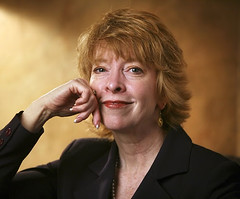 "So sorry to note that Barb Gregory is
relinquishing the helm of The Numismatist. What Barb did with the magazine is something that would even inspire Tina Brown. The cost of membership in the ANA, whatever it
was or currently is, is reaped by receiving The Numismatist. I was only with ANA for four months, when Neil Harris resigned and Barb Gregory, who was really the editor, was
one of a narrow, but strong list of candidates to succeed Neil. In the Cincinnati Convention (1988) board meeting, Gov. David Ganz mercifully and artfully resolved the issue by
making a motion to appoint Barb editor, a motion that was quickly accepted by President Steve Taylor and unanimously voted in favor by the board. Not many months later increasing
the size of the magazine from the pocket size to its current size required some careful politicking. Governor Ed Rochette, a previous editor, was our chief lobbyist.
"So sorry to note that Barb Gregory is
relinquishing the helm of The Numismatist. What Barb did with the magazine is something that would even inspire Tina Brown. The cost of membership in the ANA, whatever it
was or currently is, is reaped by receiving The Numismatist. I was only with ANA for four months, when Neil Harris resigned and Barb Gregory, who was really the editor, was
one of a narrow, but strong list of candidates to succeed Neil. In the Cincinnati Convention (1988) board meeting, Gov. David Ganz mercifully and artfully resolved the issue by
making a motion to appoint Barb editor, a motion that was quickly accepted by President Steve Taylor and unanimously voted in favor by the board. Not many months later increasing
the size of the magazine from the pocket size to its current size required some careful politicking. Governor Ed Rochette, a previous editor, was our chief lobbyist.
"Like so many, I have time to read and enjoy many of the aspects of our hobby during this time of self-isolation. My wife spends time making masks for our surgeon son-in-law."
To read the earlier E-Sylum articles, see:
NEW BOOK: THE MEDIEVAL COINS OF WüRZBURG (https://www.coinbooks.org/v23/esylum_v23n13a02.html)
NUMISMATIST EDITOR BARBARA GREGORY RETIRING (https://www.coinbooks.org/v23/esylum_v23n13a22.html)
More Tatham Stamp & Coin Co. Envelopes
Pete Smith writes:
"I don't think Tatham envelopes are very scarce. I have probably seen a hundred of them in collections I have reviewed in the past dozen years. I put a few examples on a scanner and took an image. There are probably other sizes, shapes and text."
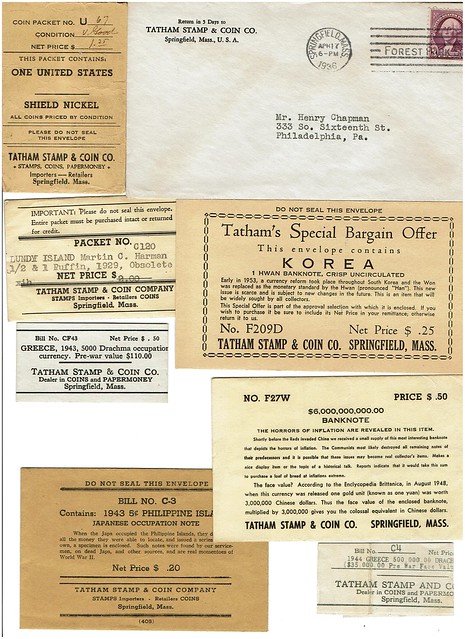
Thanks. Nice little group. I'm sure there are quite a variety of them. As a kid I ordered from Littleton but never saved any of the envelopes. There must be a lot of those out there, too. -Editor
Pete adds:
"Yes, I have some Littleton envelopes along with my Tatham envelopes. In recent years, Littleton has issued coins in clear plastic packets. I have cut open hundreds of those but I did not save the packaging."
Thanks. I've never tried collecting either the Tatham or Littleton envelopes, but it would be an interesting challenge and likely impossible to complete. -Editor
To read the earlier E-Sylum article, see:
NOTES FROM E-SYLUM READERS: MARCH 22, 2020 : Tatham Stamp & Coin Co. Envelope
(https://www.coinbooks.org/v23/esylum_v23n12a16.html)
The Marteau Early 18th Century Currency Converter
John Mellman writes:
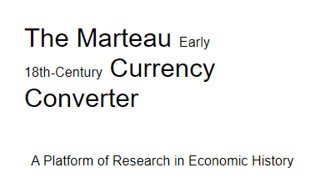 "On
ExLibris-L, Alexandra Wingate shared a link for the Marteau Early 18th Century Currency Converter. This provides a conversion between currencies of 22 states, and their
denominations.
"On
ExLibris-L, Alexandra Wingate shared a link for the Marteau Early 18th Century Currency Converter. This provides a conversion between currencies of 22 states, and their
denominations.
One can enter an amount, for example £ 5 10s 6d (English) and see that the conversion to French currency is 73 livres 13 sols tournois 4 deniers (mostly for the early 18th century or the end of the 17th). At the bottom of the screen one can see, in this example, that the general exchange rate was £3 English to 40 French livres.
This is part of the Marteau Economic History Platform, which also includes a short bibliography. It doesn't address individual coins."
Thanks. This can be useful for understanding the relative values of coins. -Editor
To access the Currency Converter, see:
The Marteau Early 18th-Century Currency Converter (http://www.pierre-marteau.com/currency/converter.html)
Book: Whitman's Coin Folders and Albums
David Lange writes:
"My book on the history of Whitman's coin folders and albums goes to layout this month, the person who performs this task also working from home as of this week. I still have to scan a few dozen additional Bookshelf albums from my collection, but she'll be working on other chapters until this last task is complete. I've lost track of the number of images involved, but it certainly will set a record for any of my books. Being at home has given me a little more time to finish the scanning and writing of captions, since I'm saving the round-trip commute three days each week, and I thus get started earlier in the evening. On those days when I do go to work I arrive in half the usual time, as there are no traffic delays beyond the occasional construction site.
"Last year The E-Sylum included my appeal to obtain or, at least, examine a complete run of the rare Whitman dealer newsletter, Coin Supply Merchandiser. It seems that Ken Bressett, who was editor for most of its run 1960-74, has the only known complete set. He generously loaned me these newsletters, and I spent many hours scanning them at 300 dpi. They are invaluable for my own research and for the photos they include that will be reproduced in my book. With Ken's permission, I sent these scans to Len Augsburger for inclusion on the Newman Numismatic Portal."
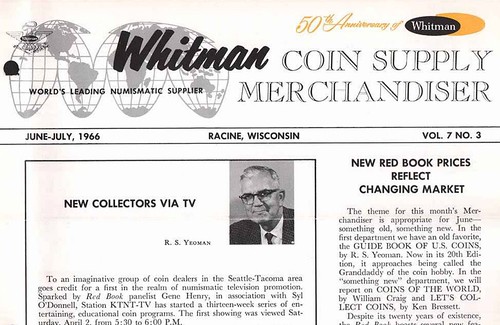
Since the Merchandiser is under copyright, the content is restricted to snippet views in search results on NNP. -Editor
For the list of Whitman Coin Supply Merchandiser holdings by year, see:
Whitman Coin Supply Merchandiser (https://nnp.wustl.edu/library/publisherdetail/535094)
To visit Dave's Coin Boards web site, see:
http://www.coincollectingboards.com/
American Journal of Numismatics 31 Errata
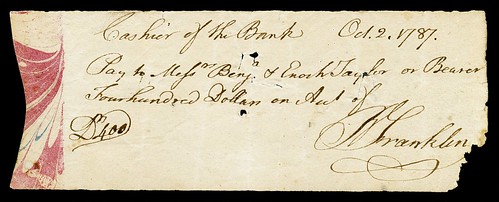
Jake Benson writes:
"I saw that you posted the Table of Contents for AJN, 31 on your site. Please note that my essay has some mistakes, omissions, and jumbled bibliography. So, Len Augsburger
kindly posted my errata list here:
https://nnp.wustl.edu/library/book/581146 ."
To read the earlier E-Sylum articles, see:
PERIODICAL: AMERICAN JOURNAL OF NUMISMATICS 31 (https://www.coinbooks.org/v23/esylum_v23n13a04.html)
SECURITY MARBLING ON FINANCIAL INSTRUMENTS (https://www.coinbooks.org/v23/esylum_v23n13a33.html)
Definition: Medio
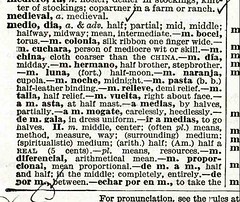 Joseph Alan Barnosky of Camden, Michigan
writes:
Joseph Alan Barnosky of Camden, Michigan
writes:
"I came across another gem from the Appleton-Century Spanish-English Dictionary, 1941. What of 5 cents before such coins were made of nickel? Half real or just plain half. (That is to say "media real" or just plain "media".) Put that in your fake news pipe and smoke it, no?"
Thanks. -Editor
On the Trail of Nazi Counterfeiters
Ray Williams writes:
"I saw the SPMC weekly newsletter and one of the links was about Nazi counterfeiting in WWII. I thought readers might enjoy it. I saw the movie The Counterfeiters and own one of the Bernard counterfeits. I'll print out this article and read it at my leisure."
Thanks. Here's the link. It's to a 2002 study declassified by the Central Intelligence Agency. -Editor
To read the complete article, see:
https://www.cia.gov/library/readingroom/docs/
STUDIES%20IN%20INTELLIGENCE%20NAZI%20-%20RELATED%20ARTICLES_0017.pdf
Bowers and Ruddy Galleries on Screen
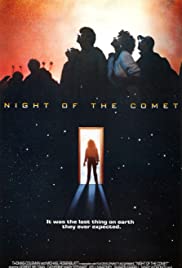 Dave Bowers writes:
Dave Bowers writes:
"To see Bowers and Ruddy Galleries on screen find the NIGHT OF THE COMET movie and go 1:35 minutes into the film!"
According to the Internet Movie Database (IMDB), in the 1984 film "A comet wipes out most of life on Earth, leaving two Valley Girls fighting against cannibal zombies and a sinister group of scientists." But do they stop to buy bullion at Bowers & Ruddy first? -Editor
To read the earlier E-Sylum article, see:
Night of the Comet (1984) (https://www.imdb.com/title/tt0087799/)
DAVID FANNING REQUESTS RESEARCH ASSISTANCE
David Fanning needs some assistance locating photos of some numismatic personalities, and certain prices realized lists. Can anyone help? -Editor
I am in the concluding phase of a book-length research project and am trying to wrap up some loose ends. I need photographs of the following individuals, and would be grateful if anyone knew where I could find one:
 • Fred Michael (Chicago
coin dealer of the 1910s)
• Fred Michael (Chicago
coin dealer of the 1910s)
• Edward Michael (his brother and business partner)
• James Macallister
• John W. Scott
• Harlan Page Smith
In the case of Scott, low-resolution photos abound online, but I need a high-resolution image that can be printed. Macallister appears in a couple of ANA convention photos from the 1930s, but I need a clearer portrait of the man. I do not recall ever seeing a photo of either of the Michael brothers or of H.P. Smith.
In addition, I need prices realized for a few lots in the Morgenthau sales of January 12-13, 1934 (Furst) and November 26, 1934 (Burrage), and I would love to talk to anyone who has a copy of the November 16, 1938 Morgenthau sale that was annotated at the sale (to check against what seems to be an error in the printed prices realized list).
Any help on the above would be greatly appreciated and properly acknowledged in the book. I can be reached at df@numislit.com. Thanks!
DEFACING COUNTERMARKED COINS MYSTERY WORD
Eric Hodge writes:
"Many thanks, once again, for your sterling efforts on our behalf with your weekly newsletter. Like nearly everyone else I am home-bound. I am making the most of this downtime by going over my long forgotten ‘to do' list.
I have not been able to read one important word on an original document related to UK merchant countermarked dollars. After a coin was countermarked with a value, it eventually became necessary to cancel that value because of movements in the silver bullion price. This is the only document discovered that refers to that process. The two images are just a reduction of the same document, with the second showing the word I need read, highlighted by the red arrows. The full sentence reads ‘Altering the head of a punch and making a new ?' If any of your readers could suggest words for the question mark, I would be in their debt.
Best wishes and Good health to all, "
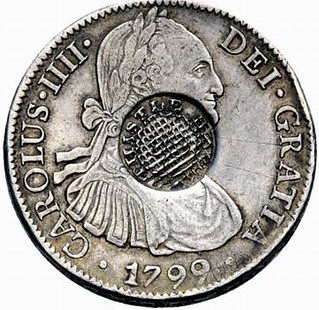
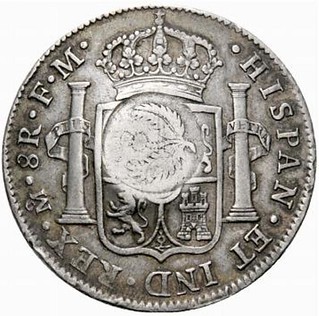
A counterstamp that has been ‘defaced'
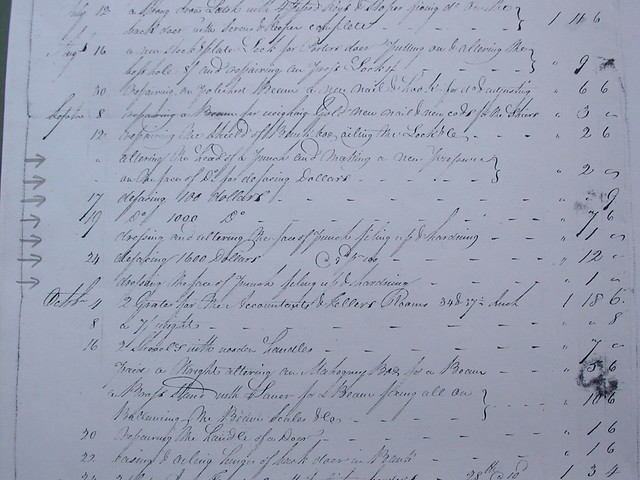

Great challenge. It's been over 200 years since this document was written. Can anyone help? As always, readers can click on an image to see the original higher-resolution version on our Flickr archive. -Editor
NATIONAL ARCHIVES TRANSCRIPTION UPDATE
Speaking of transcription, here's an update on last week's request for help transcribing U.S. Mint documents for the Newman Portal. -Editor
Roger Burdette writes:
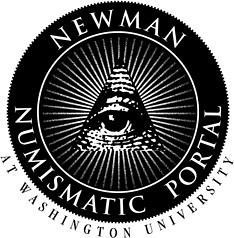 "Right now there are seven new
volunteers. Each was given a sample handwritten document to try. Everyone did well with the samples. Volunteers then received a small batch of 10 documents provided. There are no
schedules or deadlines, so everyone works at their own pace. Some volunteers have prior experience and for others this is something new to explore.
"Right now there are seven new
volunteers. Each was given a sample handwritten document to try. Everyone did well with the samples. Volunteers then received a small batch of 10 documents provided. There are no
schedules or deadlines, so everyone works at their own pace. Some volunteers have prior experience and for others this is something new to explore.
"Original materials requiring transcription range from a few very hard to read manuscripts and foreign language texts (mainly French) in archaic syntax, to typed letters that fail OCR. The originals have been edited by me from existing digital, photo and photocopy files. I've selected materials for content, interest and to illustrate economic and political conditions affecting coinage and the Mint Bureau's facilities. There is much greater emphasis on mints than assay offices, with the exception of the New York Assay Office.
"With nearly all Mint archive documents being scattered throughout millions of pages, all volunteers will likely receive a mixture of interesting and dull subjects."
One more volunteer came in this morning. Thanks for stepping up, everyone. This is a great project. Have fun! -Editor
To read the earlier E-Sylum article, see:
JOIN NATIONAL ARCHIVES TRANSCRIPTION INITIATIVE (https://www.coinbooks.org/v23/esylum_v23n13a09.html)
THE 1953 EMPEROR NORTON MEDALS
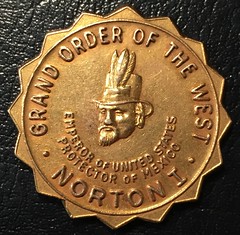
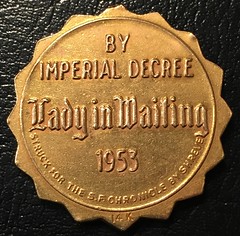
John Lumea of the Emperor Norton Trust writes:
"I have a question about the 1953 Emperor Norton gold medallion shown in a 2014 E-Sylum item.
"My guess is that the medallion — commissioned by the San Francisco Chronicle and struck by Shreve & Co. jewelers — is connected in some way to the Chronicle's Emperor Norton Treasure Hunt. Every year for a decade, 1953 to 1962, the paper for several weeks published clues to the location of a gold medallion buried somewhere in the city. The lucky reader who found the medallion could bring it to the Chronicle's offices and receive 1,000 silver dollars — sometimes more, depending on the year.
"I long have thought that the item depicted in The E-Sylum was one of the buried medallions. But, it seems this is not so.
"I just wrote this up in a Facebook post for The Emperor Norton Trust, titled "An Artifactual Conundrum of the Emperor Norton Treasure Hunt."
With permission, we're republishing John's post here. -Editor
AN ARTIFACTUAL CONUNDRUM OF THE EMPEROR NORTON TREASURE HUNT
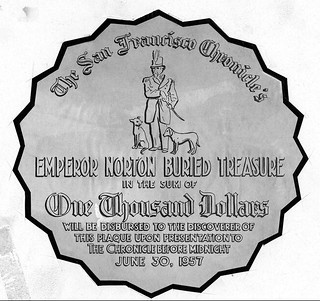 Yesterday, in this space, we
presented a photograph (which we've shown before) of the front of a medallion which appears to have been produced in connection with the San Francisco Chronicle's
Emperor Norton Treasure Hunt of 1953-62. This photo and a companion photo of the back of the medallion — first two images below — are in the "Sculptures &
Fabrications" gallery of our digital Archive of Emperor Norton in Art, Music & Film at
Yesterday, in this space, we
presented a photograph (which we've shown before) of the front of a medallion which appears to have been produced in connection with the San Francisco Chronicle's
Emperor Norton Treasure Hunt of 1953-62. This photo and a companion photo of the back of the medallion — first two images below — are in the "Sculptures &
Fabrications" gallery of our digital Archive of Emperor Norton in Art, Music & Film at
http://emperornortontrust.org/arena/visual-arts/sculptures-and-fabrications .
The star-shaped medallion, dated 1953, was made by Shreve & Co. jewelers, and we long have supposed it to be the first of the medallions buried for the Hunt.
But, a review of a photo gallery that the Chronicle published in 2018 for an historical web feature on the Hunt reveals something different.
:: :: ::
As you can see in the attached photos from the Chronicle's gallery (starting with the third image in the series below), the *buried* star-shaped medallions — also made by Shreve and placed in special wood-and-glass display boxes — are fairly large. Based on the photographs, the diameter is as much as 8 inches or more — text on each medallion calls it a "plaque."
The buried medallions feature a vignette of the Emperor full-length, hand on his sword, Bummer and Lazarus at his feet.
:: :: ::
The text and the artwork on the medallion shown in our Archive is completely different. It features the "Norton head" that appeared in the Chronicle's promotions of the Hunt. The text — including the phrases "Grand Order of the West" and "Lady in Waiting" — is somewhat inscrutable and doesn't reference the Hunt at all.
:: :: ::
Relative to the buried medallions, whose stars have 19 points, the medallion in our Archive — which has 16 points — appears to be a smaller, "handheld" piece.
An educated guess: One photograph in the Chronicle's gallery indicates that the paper threw a special "Emperor Norton dinner" in honor of the winner of the Hunt. Perhaps, on this occasion, the winner was given the smaller medallion as a keepsake.
Or, perhaps, induction into the "Grand Order of the West" was an honor the Chronicle accorded to others, but, the paper used this dinner as the occasion to present the medallion to honorees.
Or the Chronicle had a Grand Order of the West award that had no connection whatsoever to the Emperor Norton Treasure Hunt or to any Hunt-related dinner — the paper simply branded the award with Norton iconography.
Anybody have intel?
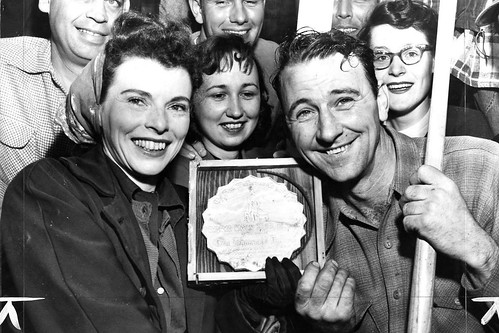
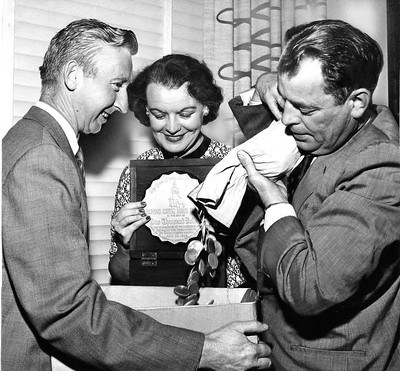
Great photos - check out the full photo gallery with the Chronicle article linked below. But it pains my numismatic heart to see the silver dollars being dumped from a bag. -Editor
To read the complete article, see:
AN ARTIFACTUAL CONUNDRUM OF THE EMPEROR NORTON TREASURE HUNT
(https://www.facebook.com/EmperorNortonTrust/posts/2630056607273255)
To read the San Francisco Chronicle article, see:
When the Emperor Norton Treasure Hunt turned San Francisco
upside down (https://www.sfchronicle.com/thetake/article/When-the-Emperor-Norton-Treasure-Hunt-turned-San-12886044.php)
To read the earlier E-Sylum article, see:
THE 1953 EMPEROR NORTON GOLD MEDAL
(https://www.coinbooks.org/club_nbs_esylum_v17n50.html#article11)
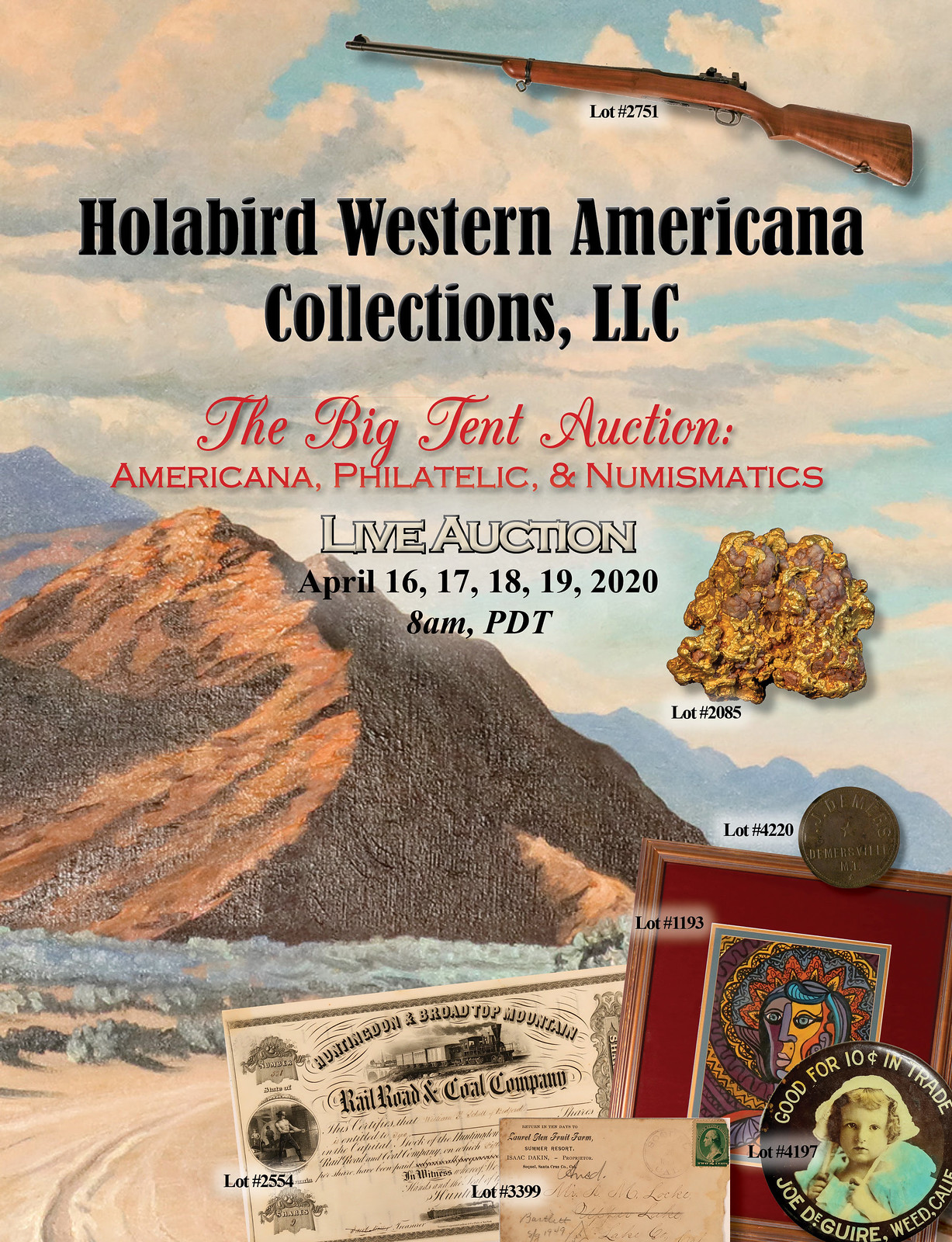
VOCABULARY TERM: KNUCKLE-JOINT PRESS
Dick Johnson submitted this entry from his Encyclopedia of Coin and Medal Terminology. Thanks. -Editor
Knuckle-joint Press. A press whose action is based on a hinged joint and flywheel. This type of press has a relative long extrusion dwell, particularly useful for preventing the springing back of the surface metal. This type of striking is ideal for both numismatic and medallic items, in fact more of the world's coins and medals have been struck on knuckle- joint presses than any other.
Coining presses. The first knuckle-joint press for coining, the Uhlhorn, was invented by Diedrich Uhlhorn in Germany in 1812 (and patented in 1817). This was intended to replaced the screw press, which had been used for over 300 years (but was not until the end of the 19th century when knuckle-joint presses could be electrified with greater ease than screw presses that the screw press was ultimately phased out of any coining mint).
From the beginning Uhlhorn presses had automatic feed and delivery systems. It also incorporated the collar for forming the edge treatment of struck pieces, either smooth or reeded. Uhlhorn established a factory in Grevenbroich, Germany in 1817 for the purpose of building presses for minting coins and it continued in operation until at least 1880.
Although Uhlhorn was preceded by a hand cranked knuckle-joint press devised by Russian mintworker at the Saint Petersburg Mint, I.A. Nevedomskiy in 1811, his manually operated press was never placed into production. A drawing has survived however.
In 1836 the Uhlhorn press was modified by a Frenchman, who created the Thonnelier press, and mints of the world used either or both type presses for over 150 years and both are still in use. A toggle-action press was evolved from the knuckle-joint and all coining presses built after about 1860 are optional knuckle-joint or toggle-action mechanics. German and English firms have dominated the manufacture of these coining presses (but some coining presses have been made in America, Austria, Belgium and Sweden).
Knuckle-joint presses were originally powered by steam engines (infrequently by water power) until 1890. Thus steam engines (as Boulton and Watt's engines) were just as necess- ary for mints as Uhlhorn's coining presses. The power was transferred to the press by belting. After 1890 most all presses were electrified and driven by electric motors. America's Third Mint in Philadelphia built in 1901 became the first all-electric mint in the world; twelve Morgan & Orr knuckle-joint presses were moved from the old Second Mint to the new mint and electrified.
Medal presses. Presses for striking medals can be either knuckle-joint or hydraulic. The advantages of the knuckle-joint are a sharper blow, a longer extrusion dwell and higher productions speeds. Hydraulic presses, while slower in production, can develop a more forceful "squeeze" displacing more surface metal with each press cycle making them more suitable for high relief multiple struck medals with fewer blows and intermediate annealing necessary.
Knuckle-joint is sometimes called knee-action. See presses and pressroom practice.
Looking for the meaning of a numismatic word, or the description of a term? Try the Newman Numismatic Portal's Numismatic Dictionary at: https://nnp.wustl.edu/library/dictionary
Or if you would like a printed copy of the complete Encyclopedia, it is available. There are 1,854 terms, on 678 pages, in The Encyclopedia of Coin and Medal Technology. Even running two a week would require more than 19 years to publish them all. If you would like an advance draft of this vital reference work it may be obtained from the author for your check of $50 sent postpaid. Dick Johnson, 139 Thompson Drive, Torrington, CT 06790.
CALVIN WESTLEY FRANKLIN (1854-1911)
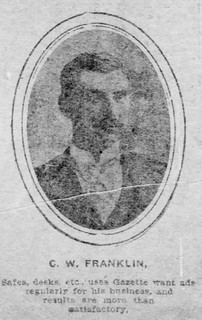 Who in the world is
Calvin Westley Franklin (1854-1911)? He is an aloof and evasive figure in American numismatic history though he was a successful coin dealer for at least seven years and published
several numismatic publications. Though we know sufficiently about his numismatic dealings we know virtually nothing about him as a person. Did he have children? Where did he go
to school, and so forth? Carefully studying his penmanship and spelling skills in the Chapman Brothers correspondence it is obvious he did not attend college and therefore used
the title Doctor rather loosely. These and many other personal questions remain unanswered about his private life and background.
Who in the world is
Calvin Westley Franklin (1854-1911)? He is an aloof and evasive figure in American numismatic history though he was a successful coin dealer for at least seven years and published
several numismatic publications. Though we know sufficiently about his numismatic dealings we know virtually nothing about him as a person. Did he have children? Where did he go
to school, and so forth? Carefully studying his penmanship and spelling skills in the Chapman Brothers correspondence it is obvious he did not attend college and therefore used
the title Doctor rather loosely. These and many other personal questions remain unanswered about his private life and background.
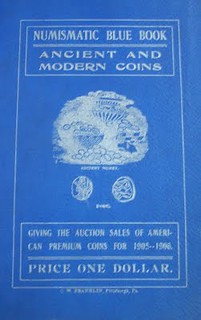 Curiously he frequently went about with
the title Doctor C. W. Franklin, yet no record of his college studies has yet been discovered. After reading his postal cards sent to the Chapman Brothers it is clear he had very
little schooling and was an unlettered man. We know nothing of his personality and character which very well may have amply compensated him for his lack of eloquence and
refinement. We can only assume he was a cheerful man of good character which is reflected somewhat in two feature articles about him and coins published later on. His enthusiasm
and passion for coins is very evident in his advertisements and letters as well as in his 1907 book that seems to have become completely forgotten and lost to posterity save the
two extant copies.
Curiously he frequently went about with
the title Doctor C. W. Franklin, yet no record of his college studies has yet been discovered. After reading his postal cards sent to the Chapman Brothers it is clear he had very
little schooling and was an unlettered man. We know nothing of his personality and character which very well may have amply compensated him for his lack of eloquence and
refinement. We can only assume he was a cheerful man of good character which is reflected somewhat in two feature articles about him and coins published later on. His enthusiasm
and passion for coins is very evident in his advertisements and letters as well as in his 1907 book that seems to have become completely forgotten and lost to posterity save the
two extant copies.

The Numismatist July 1907
He was born the second son of four children to John Franklin (1826-1905) and Nancy Skinner (1833-1919) on April 12, 1857 at Marietta, Ohio. Franklin left his family who moved to West Virginia, and after finishing school set out as a traveling salesman eventually settling at Pittsburgh sometime around 1901.
Franklin is an interesting personality judging from his myriad of newspaper advertisements and numerous correspondence with the Chapman Brothers. He sold coins, paper money, rare gold, stamps, curiosities, Indian relics, cash registers, and fire and burglar proof safes.
The mysterious Doctor C. W. Franklin seems to have styled himself after Ben Franklin who also was called Doctor Franklin. He certainly created a breeze in the Pittsburgh coin world but seems to have been a dud in the mainstream of coin collectors and dealers never having been a member of any numismatic association unless this author's weary eyes missed that entry. Reading through his numerous advertisements which only a few have been published here one learns he dealt with a wide variety of gold coins and other rarities.
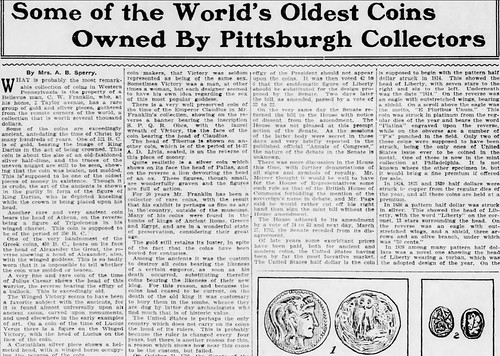
To read the complete article, see:
FRANKLIN, CALVIN WESTLEY
(https://sites.google.com/a/numismaticmall.com/www/numismaticmall-com/franklin-c-w)
CSNS PRESIDENT ANNOUNCES 2020 SOWER RECIPIENTS
Central States Numismatic Society President Mitch Ernst has announced the winners of his 2020 Sower Award. -Editor
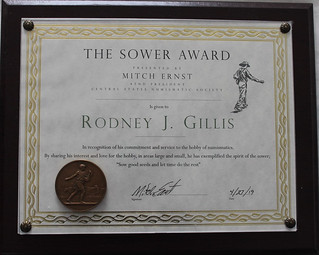 CSNS president, Mitch
Ernst, has announced the recipients of his 2020 Sower Awards. "It is my privilege to bestow my 2020 "Sower Award" to four people who, from my observation and
experience, epitomize the spirit of the 'sower'." The sower is an allegorical image of a person planting seed in a field portraying hope for the future. The four
recipients for 2020 are: Barbara Gregory, Brett Irick, David Heinrich and Thomas Uram.
CSNS president, Mitch
Ernst, has announced the recipients of his 2020 Sower Awards. "It is my privilege to bestow my 2020 "Sower Award" to four people who, from my observation and
experience, epitomize the spirit of the 'sower'." The sower is an allegorical image of a person planting seed in a field portraying hope for the future. The four
recipients for 2020 are: Barbara Gregory, Brett Irick, David Heinrich and Thomas Uram.
"All of these individuals have planted seeds into the future of hobby without thought of themselves. They have shown by example the spirit of the sower, "Sow good seeds and let time do the rest." said Ernst.
The presentation of the awards was going to take place at the now canceled CSNS convention in Schaumburg, IL on April 25th. The awards will now be either mailed to the recipients or presented at the World's Fair of Money in Pittsburgh in August.
Ernst collects coins, medals, currency, etc.with the image of the sower and each award will have a medal from his collection attached to it.
The picture is of a 2019 award presented to ANA Education Director, Rod Gillis. Other 2019 recipients were; Clifford Mishler, Dave Harper, Walt Ostromecki and Rick Snow.
The Seed Sower design by Oscar Roty is a classic, and a great choice for an award. Here's an example of the design on a French 5 Franc coin from NGC's World Coin Price Guide. -Editor
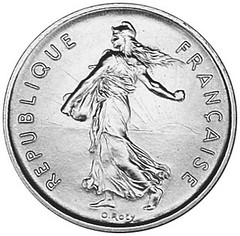
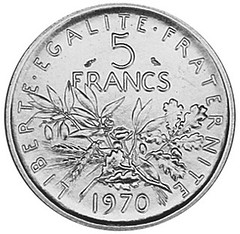
To read the NGC entry, see:
France 5 Francs KM# 926a.1
(https://www.ngccoin.com/price-guide/world/france-
5-francs-km-926a.1-1970-2001-cuid-1127186-duid-1265939)
To more information on the Central States Numismatic Society, see:
https://www.centralstatesnumismaticsociety.org/
NATIONAL EMERGENCY LIBRARY ANNOUNCED
The Internet Archive has announced the temporary opening of the "National Emergency Library", an online resource for access to books owned by institutions participating in IA's Open Library program. Here's an excerpt from the press release - see the complete version online. -Editor
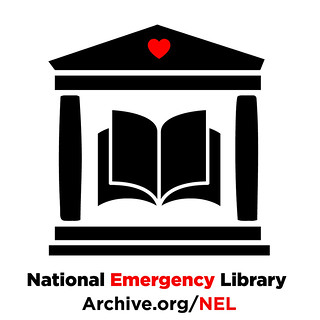 To address our unprecedented global and
immediate need for access to reading and research materials, as of today, March 24, 2020, the Internet Archive will suspend waitlists for the 1.4 million (and growing) books in
our lending library by creating a National Emergency Library to serve the nation's displaced learners. This suspension will run through June 30, 2020, or the end of the US
national emergency, whichever is later.
To address our unprecedented global and
immediate need for access to reading and research materials, as of today, March 24, 2020, the Internet Archive will suspend waitlists for the 1.4 million (and growing) books in
our lending library by creating a National Emergency Library to serve the nation's displaced learners. This suspension will run through June 30, 2020, or the end of the US
national emergency, whichever is later.
During the waitlist suspension, users will be able to borrow books from the National Emergency Library without joining a waitlist, ensuring that students will have access to assigned readings and library materials that the Internet Archive has digitized for the remainder of the US academic calendar, and that people who cannot physically access their local libraries because of closure or self-quarantine can continue to read and thrive during this time of crisis, keeping themselves and others safe.
This library brings together all the books from Phillips Academy Andover and Marygrove College, and much of Trent University's collections, along with over a million other books donated from other libraries to readers worldwide that are locked out of their libraries.
This is a response to the scores of inquiries from educators about the capacity of our lending system and the scale needed to meet classroom demands because of the closures. Working with librarians in Boston area, led by Tom Blake of Boston Public Library, who gathered course reserves and reading lists from college and school libraries, we determined which of those books the Internet Archive had already digitized. Through that work we quickly realized that our lending library wasn't going to scale to meet the needs of a global community of displaced learners. To make a real difference for the nation and the world, we would have to take a bigger step.
“The library system, because of our national emergency, is coming to aid those that are forced to learn at home, ” said Brewster Kahle, Digital Librarian of the Internet Archive. “This was our dream for the original Internet coming to life: the Library at everyone's fingertips.”
Public support for this emergency measure has come from over 100 individuals, libraries and universities across the world, including the Massachusetts Institute of Technology (MIT). “Ubiquitous access to open digital content has long been an important goal for MIT and MIT Libraries. Learning and research depend on it,” said Chris Bourg, Director of MIT Libraries. “In a global pandemic, robust digital lending options are key to a library's ability to care for staff and the community, by allowing all of us to work remotely and maintain the recommended social distancing.”
We understand that we're not going to be able to meet everyone's needs; our collection, at 1.4 million modern books, is a fraction of the size of a large metropolitan library system or a great academic library. The books that we've digitized have been acquired with a focus on materials published during the 20th century, the vast majority of which do not have a commercially available ebook. This means that while readers and students are able to access latest best sellers and popular titles through services like OverDrive and Hoopla, they don't have access to the books that only exist in paper, sitting inaccessible on their library shelves. That's where our collection fits in—we offer digital access to books, many of which are otherwise unavailable to the public while our schools and libraries are closed.
To read the complete press release, see:
Announcing a National Emergency Library
to Provide Digitized Books to Students and the Public
(http://blog.archive.org/2020/03/24/announcing-a-national-emergency-library-to-provide-digitized-books-to-students-and-the-public/)
To visit the National Emergency Library, see:
https://archive.org/details/nationalemergencylibrary
Here's an excerpt from a National Public Radio (NPR) article on the topic. -Editor
Last week, when the Internet Archive announced its "National Emergency Library," expanding access to more than a million digitized works, the group explained the move as a goodwill gesture in the time of coronavirus.
With so many brick-and-mortar libraries forced to close their doors, in other words, the group was opening up its lending program: Now, instead of its usual policy of just one digital copy per reader for a 14-day period, many frustrated readers could borrow copies of the same book during the same time — and could do so through the end of June or the end of the global pandemic, whichever came sooner.
But there's one major issue that several media outlets, including NPR, failed to mention in covering the decision: Many writers and publishers say the website, even before the creation of this National Emergency Library, has been sharing full digital copies of their books without their permission.
And over the weekend, dozens of prominent authors, from Colson Whitehead and Neil Gaiman to Alexander Chee, made clear that they were upset with the Internet Archive's model — and doubly so now, with the expansion of lending services and its timing.
The guild said that last year alone it sent the organization hundreds of takedown notices on behalf of the writers it represents, citing the Digital Millennium Copyright Act. The 1998 law lays a framework for preventing users from creating digital copies of copyrighted material and circulating it without the copyright holder's permission.
The Internet Archive pushed back against this characterization with a lengthy rebuttal published online Monday.
Kahle said the group uses the same controls limiting access to these works as the publishers themselves, with encrypted files that are meant to disappear from the user's computer after a brief period. The copies the group lends, Kahle said, are owned by the Internet Archive — either through donations, straight-up purchases or collaborations with brick-and-mortar libraries.
Typically, Kahle said readers can obtain just one copy of a book at a time through the Internet Archive. He said the difference with the "National Emergency Library," with waitlists now suspended through the end of June, is that those limits have been removed and multiple copies of the same book are now available.
To read the complete article, see:
Authors, Publishers Condemn The 'National Emergency
Library' As 'Piracy' (https://www.npr.org/2020/03/30/823797545/authors-publishers-condemn-the-national-emergency-library-as-piracy)
Here are excerpts from the Author's Guild statement. -Editor
The Authors Guild is appalled by the Internet Archive's (IA) announcement that it is now making millions of in-copyright books freely available online without restriction on its Open Library site under the guise of a National Emergency Library. IA has no rights whatsoever to these books, much less to give them away indiscriminately without consent of the publisher or author. We are shocked that the Internet Archive would use the Covid-19 epidemic as an excuse to push copyright law further out to the edges, and in doing so, harm authors, many of whom are already struggling.
A is using a global crisis to advance a copyright ideology that violates current federal law and hurts most authors. It has misrepresented the nature and legality of the project through a deceptive publicity campaign. Despite giving off the impression that it is expanding access to older and public domain books, a large proportion of the books on Open Library are in fact recent in-copyright books that publishers and authors rely on for critical revenue. Acting as a piracy site—of which there already are too many—the Internet Archive tramples on authors' rights by giving away their books to the world.
Last year, the Authors Guild and authors sent hundreds of takedown notices to IA and protested the inclusion of their books in the Open Library program. Now, during this pandemic that has severely disrupted authors' lives and choked the publishing industry, IA once again is undermining authors' ability to make a living and decide who gets access to their copywritten material.
To read the complete Author's Guild statement, see:
Internet Archive's National Emergency Library Harms Authors
(https://www.authorsguild.org/industry-advocacy/internet-archives-uncontrolled-digital-lending/)
ROBINSON ANCIENT COIN SALE 112 ANNOUNCED
Here's the press release for Frank Robinson's upcoming sale of ancient and early coins. -Editor
Dealer Frank S. Robinson will conduct his 112th mail and internet auction of Ancient and Early Coins with a closing date of May 5. The sale will include 487 lots, with low minimum bids, and bids to be reduced as competition permits. Robinson notes that reductions have averaged 15-20% in his recent sales. There is no buyer fee.
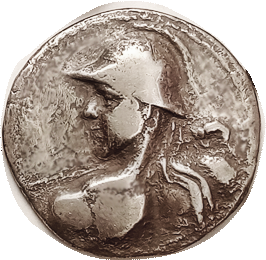
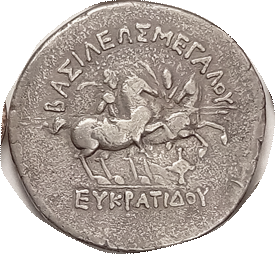
Lot 18: Baktrian Tetradrachm of Eukratides I
Noteworthy among Greek coins in the sale are several classic Athenian “Owl” Tetradrachm in Choice EF to Mint State; an affordable Baktrian Tetradrachm of Eukratides I with rare heroic bust; two rare early Elymais silver tetradrachms; an attractive and rare Olympia stater; an early Corinthian stater with swastika pattern reverse graded VF; a rare Persis Tetradrachm of Bagadates I in VF; and good run of Parthian coins.
Roman highlights include a nice VF Livia Dupondius; a “Tribute Penny” denarius in EF; a rare left-bust Galba denarius in Choice VF; and an EF Diadumenian denarius.
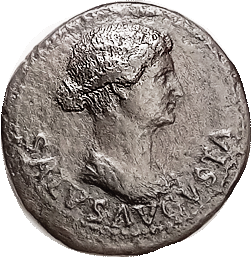
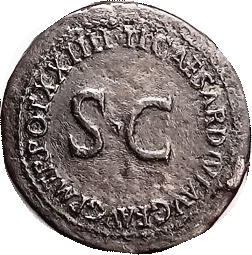
Lot 210: Livia Dupondius
The auction also includes Byzantine and other early coinages, group lots, literature, and a section of items offered at fixed prices
Robinson holds about three such sales annually, and tries to offer a broad range of material for advanced collectors as well as bargain hunters. Catalogs are free; contact Robinson at Box 8600A, Albany, NY 12208; phone/fax 518-482-2639; e-mail frank@fsrcoin.com. The full catalog will be at his website,
To visit Frank's website, see:
http://www.fsrcoin.com/

ARCHIVES INTERNATIONAL SALE 58 ANNOUNCED
Here is the announcement for the April 2020 sale by Archives International. Check the online listings carefully - some interesting items here. I picked a few in last week's Selections article (linked below). -Editor
U.S., CHINESE & WORLDWIDE BANKNOTES, COINS, SCRIPOPHILY AND HISTORIC DOCUMENTS TO BE OFFERED AT PUBLIC AUCTION ON TUESDAY & WEDNESDAY APRIL 7th & 8th, 2020
The auction will be held by Archives International Auctions at their new offices in River Edge, N.J.
The April 7th and 8th, 2020 two-day auction by Archives International Auctions will consist of 1327 different lots offered over 2 days beginning with 628 lots of Worldwide, Chinese & U.S. Banknotes, Chinese Scripophily, Security Printing Ephemera, Historic Documents and World Coins. The second session features U.S. & World Scripophily with over 698 lots of Railroads, Mining, Banking, Navigation, World and numerous additional topics.
“We hope this auction will offer our clients and friends a little enjoyment during this trying time period”, stated Dr. Robert Schwartz, President of Archives International Auctions. “We have included a wide variety or rare, interesting and desirable material to enhance your collections for every level of collector or dealer”.
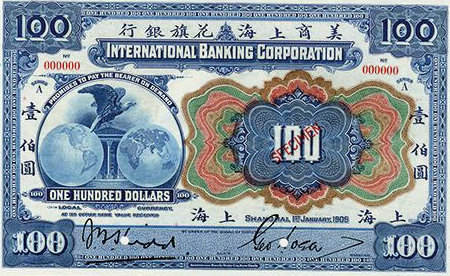
Lot 126: 1905 International Banking Corporation $100 Note
Included in the first session on Tuesday, April 7th, are consignments from numerous estates and longtime collections with many items having never been offered previously at auction. China features over 80 lots with a number of highlights including a high grade $100 International Banking Corporation Specimen rarity; a 1912, $1, Bank of China, Peking Branch Issue Rarity; as well as numerous desirable issued and specimen notes; Additionally, there are 17 lots of desirable Chinese Bonds & Shares highlighted by a group of 1919, £100 & £500 Pound Sterling, Vickers Loans. Canada is highlighted by a 1935, $20 Bank of Canada “English” version note; A Denmark. 1784, 1 Rigsdaler Courant, P-A24c rarity, possibly the finest known is offered; Other exceptional foreign banknote highlights include a Hong Kong, Chartered Bank of India, Australia & China, 1940, $5 note PMG graded VF 35 EPQ; Mexico is represented by over 20 lots including many rare and desirable issued, proof and specimen notes; The Strait Settlements is highlighted by a delightful and rare $10, Government of the Straits Settlements, 1929 Issue Banknote Rarity; India is highlighted by a Princely States / Hyderabad, ND (1945-46) 100 Rupees Issued banknote; We are fortunate to have 2 old time banknote collections consigned to us that were put together in the 1960 to 1980s that we will begin offering over the next few auctions as single and group lots as well as hundreds of other desirable banknotes that are too numerous to mention.
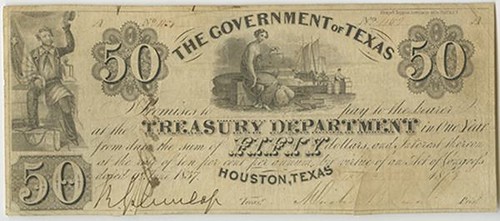
Lot 566: 1837 Government of Texas $50 note
The U.S. section of Session 1 on the first day includes 80 lots of Obsolete banknotes, Security Printing Ephemera and Historic Documents and Ephemera. Highlights include an original 4 subject Obsolete printing plate from the City Bank (of Augusta, Georgia), 1860's, $1-1-1-2, Haxby, GA50G2b-G4b and 2 additional lots of proprietary modern reprint proof sheets from the same plate; a Government of Texas, 1837, $50 Cut Cancelled Obsolete note; as well as original artwork from ABN used in the design and production process of stocks and bonds. Numerous security printing items, national banknotes and other notes highlight this portion of the auction.
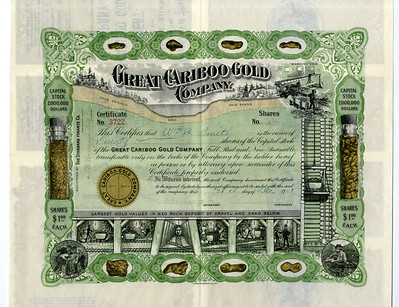
Lot 937: 1908 Great Cariboo Gold Company Stock Certificate
Session 2, scheduled for Wednesday, April 8th, will consist of 698 lots of U.S. and World scripophily highlighted by 305 lots of rare and desirable Railroad bonds and shares; and over 70 lots of mining stocks and bonds. Highlights include an 1886, The Audubon Society Membership certificate; a Mexico, Ferrocarril Nacional de Tehuantepec 1890 Specimen Bond Rarity; a dramatic and impressive South Dakota, Great Cariboo Gold Company, 1908 I/U Stock Certificate and hundreds of other rare, desirable and attractive bonds and shares from automobiles to Zoo's with every topic in between that should appeal to all levels of collectors and dealers.
Previews will be limited and by appointment only. We will do our best to accommodate anyone who desires additional information and photographs. For questions, please call 201-944-4806 or email info@archivesinternational.com .
The Online Catalog for the April 7th and 8th sale is on Archives International Auctions' website and can be viewed via the Archives International live bidding platform. It can also be viewed as a Virtual Catalog or downloadable Sale 58 .pdf on their website. To pre-register for live internet bidding, log on to the Archives International Auctions website, at www.ArchivesInternational.com .
Archives International is now working on their Spring and Summer 2020 auctions and are seeking quality consignments for future auctions or outright purchase including U.S. and worldwide banknotes, coins, stocks, bonds, stamps, postal history, historic ephemera, and autographs. To sell or consign one piece or an entire collection, please call AIA at (201) 944- 4800; or e-mail them at info@archivesinternational.com .
You may also write to Archives International Auctions, at 1060 Main Street, River Edge, NJ 07661, U.S.A. To learn more about Archives International Auctions and the auctions planned for April 7th and 8th, 2020, log on to www.ArchivesInternational.com .
LINKS:
Online Catalog (https://auction.archivesinternational.com/auctionlist.aspx)
Virtual Catalog
(https://archivesinternational.auctioneersvault.com/catalog/Archivessale58/)
downloadable
Sale 58 .pdf (https://archivesinternational.auctioneersvault.com/catalog/
Archivessale58/files/assets/common/downloads/
Archives%20International%20Auctions%20Sale%2057.pdf)
To read the earlier E-Sylum article, see:
ARCHIVES INTERNATIONAL SALE #58 SELECTIONS (https://www.coinbooks.org/v23/esylum_v23n13a31.html)
SELECTIONS FROM HOLABIRD APRIL 2020 SALES
Here's are some lots that caught my eye this week in the upcoming Holabird sale. -Editor
Lot 1368: Gen. and Mrs. Tom Thumb Wedding Circus Token
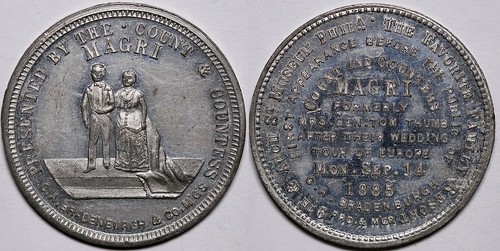
Obv.: Presented by the Count & Countess / Magri / (pictorial couple) / C. A. Bradenburgh & Co. M'G's; Rev.: 9th & Arch St. Museum Phila The Favorite Family Resort / First Appearance Before the Public of / Count and Countess / Magri / Formerly / Mrs. Gen. Tom Thumb / After Their Wedding / Tour of Europe / Mon. Sep. 14 / 1885 / C. A. Bradenburgh / Pro. & Mgr. Wm, rd., 32 mm, almost uncirculated with luster in the fields. Count Primo Magri (1849–1920) and Count Rosebud were the stage names of a 19th-century Italian dwarf who married Lavinia Warren, the widow of General Tom Thumb on Easter Monday, April 6, 1885, at the Church of the Holy Trinity in New York City. "The Autobiography of Mrs. Tom Thumb," was written by Melanie Benjamin in 2011.
The Meghan and Harry of the day! -Editor
To read the complete lot description, see:
Gen. and Mrs. Tom Thumb Wedding Circus Token (116501)
(https://www.icollector.com/Gen-and-Mrs-Tom-Thumb-Wedding-Circus-Token-116501_i36573943)
Lot 1374: Yankee Robinson's Big Show Circus Tokens
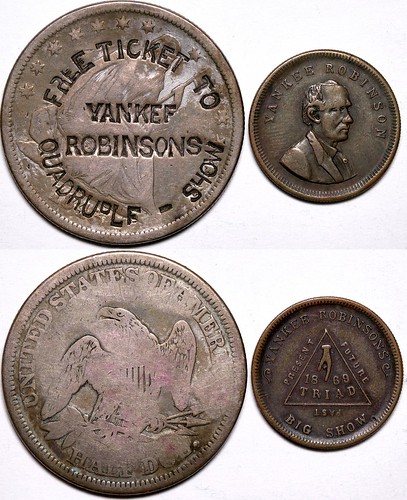
Lot of two: 1) Obv.: Yankee Robinson / (portrait) Rev.: Yankee Robinsons / Present / Future / 1869 / Triad / Past / Big Show; Br. rd., 19 mm. 2) Counterstamped seated liberty half dollar: "Free Ticket To / Yankee / Robinsons / Quadruple - Show." Date appears to be 1843. Fayette Lodawick Robinson was born on May 2, 1818, in Livingston County, New York. While a teenaged student in his native town, he made his first stage appearance in a school play, in the role of Jonathan Doolittle in A Yankee in England. This may have inspired his nickname. He went on to live his life on the stage and under the circus tent, in the 1850s and 1860s achieving great fame amid making money one year and losing it in the next.
Provenance: John Reynolds Collection
Nice pair. I don't believe I've seen this "Quadruple - Show" variety of the Robinson counterstamp before. -Editor
To read the complete lot description, see:
Yankee Robinson's Big Show Circus Tokens (116500)
(https://www.icollector.com/Yankee-Robinson-s-Big-Show-Circus-Tokens-116500_i36573949)
Lot 4206: Acme Beer Token
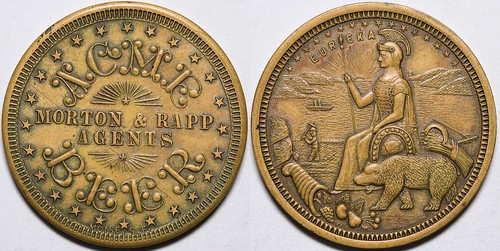
Obv.: Acme / Morton & Rapp / Agents / Beer; Rev.: California seal "Eureka" with Minverva. Br., rd., 35 mm.
Provenance: John Reynolds Collection
Neat token. Very California. -Editor
To read the complete lot description, see:
Acme Beer Token (115450) (https://www.icollector.com/Acme-Beer-Token-115450_i36576111)
Lot 4293: Morgan Dollar with Advertising Decal
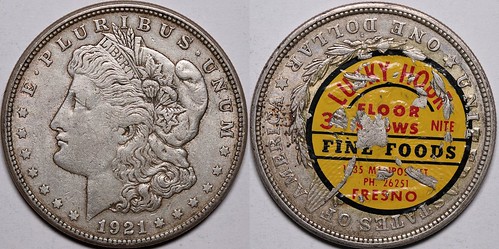
1921 Morgan dollar with a reverse decal advertising Lucky Hour Fine Foods. Coin is VG-F condition.
Provenance: John Reynolds Collection
As noted in our April Fool 2020 article elsewhere in this issue, stickered coins do carry a premium. Maybe not banana labels, though. -Editor
To read the complete lot description, see:
Morgan Dollar with Advertising Decal (116534)
(https://www.icollector.com/Morgan-Dollar-with-Advertising-Decal-116534_i36576198)
Lot 4347: 1930 Crane Co. 75th Anniversary Medal
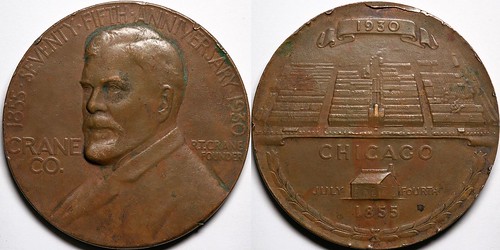
1930 Crane Co. 75th Anniversary Medal. Designed by John Ray Sinnock and struck by the Medallic Art Company. Bust of founder Richard T. Crane on the obverse. Reverse shows the Crane factory in 1930 and the original factory building in 1855 below. J©S obscured by rim ding at 6 o'clock. Medallic Art Company stamp along rim at six o'clock. Bronze, 63mm EF, rim dings.
A Mint engraver's medal for the Chicago Crane company (not the banknote paper maker). -Editor
To read the complete lot description, see:
Crane Co 75th Anniv Medal, by John Sinnock (116184)
(https://www.icollector.com/Crane-Co-75th-Anniv-Medal-by-John-Sinnock-116184_i36576252)
Lot 4365: International Exposition of Arts and Crafts Medal
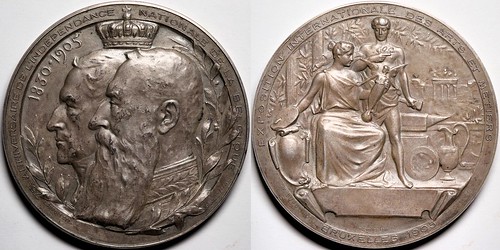
1905 Medal for the International Exposition of Art and Crafts, Brussels. Obverse: Kings Leopold I and Leopold II in celebration of the 75th anniversary of Belgian Independence. Signed E. DUPUIS DEL. Reverse Muse with sculpture, pottery, paint palette, and other symbols of arts and craft. Blank scroll below. Signed (incuse) E. DUPUIS DEL. Signed by the maker, MASSONNET ÉDIT, a French firm. Edge marked BRONZE with a CTM hallmark. Silver plated bronze, 67mm. Unc with box of issue.
Nice medal. A lot is squeezed in here, but it's well balanced and looks nice. -Editor
To read the complete lot description, see:
Int'l Exposition of Arts and Crafts Medal (116187)
(https://www.icollector.com/Int-l-Exposition-of-Arts-and-Crafts-Medal-116187_i36576270)
Lot 4402: $10 Fresno County Vineyard & Distillery Scrip Note
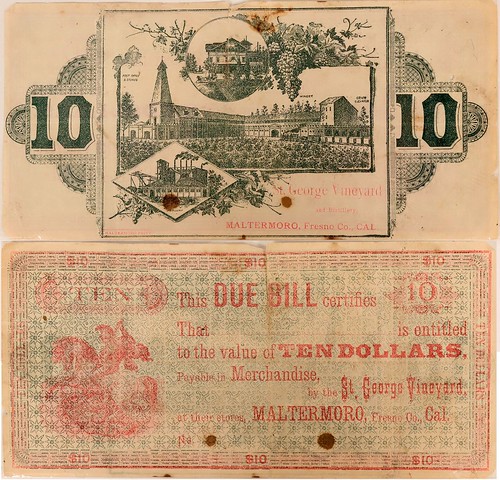
Rare pictorial $10 scrip note for the St. George Vineyard and Distillery, Maltermoro, Fresno Co., Cal. Payable in Merchandise at their stores. Red and green print with illustrated underprint. Front has vignette of St. George slaying a dragon. Reverse has vignettes of the vineyard, winery, distillery, and post office and stores. Printed by Maltermoro Print. Fold with separation, some staining, wear to edges. Please inspect. 4 x 8.25" The St. George Vineyard was located five miles east of Fresno on 1280 acres and was owned by George H. Malter (namesake of Maltermoro). It was established in 1879. The winery was built in 1888. In 1895, a retail store was established in Fresno for the sale of wine and brandy.
Provenance: John Reynolds Collection
A rare and unusual scrip note. Neat item. -Editor
To read the complete lot description, see:
Rare $10 Fresno County Vineyard & Distillery Scrip Note (115487)
(https://www.icollector.com/Rare-10-Fresno-County-Vineyard-Distillery-Scrip-Note-115487_i36576307)
SELECTIONS FROM HERITAGE APRIL 2020 SALES
Here are some lots that caught my eye in the upcoming Heritage April 2020 sales. -Editor
Lot 30410: Haiti Henri Christophe 15 Sols Silver Pattern
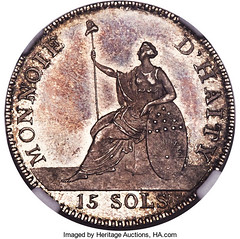
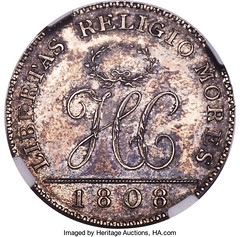
Northern Haiti. Henri Christophe silver Pattern 15 Sols 1808 MS63 NGC, Birmingham mint, KM-Pn7, Fonrobert-7488. A choice example of this scarce issue decorated in delicate silver tones over flashy fields, enhancing the presentation of sharp devices rendered to pinpoint accuracy.
Commissioned by Henri Christophe in England as part of the project to improve the crude issues of the State of Haiti struck in Cap Haitien. Commercial agent of Henri Christophe, Jean Gabriel Peltier, contacted Matthew Boulton on January 25, 1808, to manufacture dies for three denominations, 30, 15 and 7.5 sols, equivalent to the English 1 shilling, sixpence and threepence. The dies, while differing from the original sketches furnished by Peltier, which stipulated an obverse with a four-line inscription "ETAT - d'HAITY - PIECE DE - 30 SOLS" encircled in a laurel wreath, were skillfully made, as evidenced by the present specimen. They were manufactured at a cost of 105 guineas and delivered to Peltier by John Woodward (agent of Boulton, Watt & Co. in London) on August 3, 1808, together with various Proof sets: 3 triple sets (3 coins per denomination) and 3 normal Proof sets (1 coin per denomination). Together with some pieces undoubtedly kept by Boulton himself (note that many of the few surviving specimens have surfaced in the UK), the former sets account for the scant surviving examples of these charming patterns.
To read the complete lot description, see:
Haiti: Northern Haiti. Henri Christophe silver
Pattern 15 Sols 1808 MS63 NGC,. (https://coins.ha.com/itm/haiti/haiti-northern-haiti-henri-christophe-silver-pattern-15-sols-1808-ms63-ngc-/a/3083-30410.s)
Lot 31036: Constantine the Great Gold Medallion
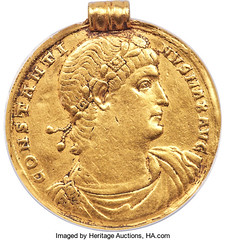
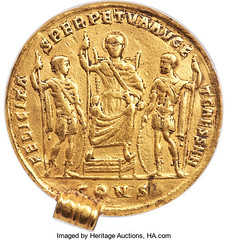
Constantine I the Great (AD 307-337). AV medallion of 9 solidi (47mm, 41.88 gm, 5h). NGC Choice VF 5/5 - 2/5, Fine Style, mount. Constantinople, ca. AD 330. CONSTANTI-NVS MAX AVG, laurel and rosette diademed, draped and cuirassed bust of Constantine I right, seen from front / FELICITA-S PERPETVA AVG E-T CAESS NN, Constantine I, nimbate, enthroned facing, scepter in right hand, mappa in left, flanked by Constantine II and Constantius II, both standing facing in military dress and turned to center, spear in outer hand, inner hand resting on grounded shield; CONS in exergue. RIC VII -. Cohen -. Depeyrot -. cf. Toynbee, p. 198 n. 45; pl. XXXIX, 1 [Constantine II, Constantinople]. cf. Gnecchi p. 16, 11, Nicomedia = Babelon, Revue Numismatique, 1906, "La trouvaille de Helleville (1780)", p. 167, pl. VII, 2 = Babelon, La Trouvaille Monétaire de Helleville (Manche) En 1780, 1910, pp. 16-17, pl. 1, 2 = Toynbee, Roman Medallions, Numismatic Studies 5, p. 62, n. 36, pl. V, 5 = RIC VII Nicomedia 173. An impressive medallion with contemporary intact mount, likely unique.
Gold medallions were gifts produced for the emperor to bestow upon high ranking civilian and military individuals, as well as "foreign ambassadors and chieftains whom it was intended to impress." They were "the imperial counterpart of private gifts presented to friends on important occasions." Described by Toynbee as money medallions because they were "true multiples of gold and silver coins" and could therefore legally used as money, they ranged in size from "the 1 ½-solidi pieces first issued by Constantine I to the 72-solidi piece of Valens."
An important piece. -Editor
To read the complete lot description, see:
Ancients:
Constantine I the Great (AD 307-337). AV medallion of 9 solidi (47mm, 41.88 gm, 5h). NGC Choice VF 5/5 - 2/5..
(https://coins.ha.com/itm/ancients/roman-imperial/ancients-constantine-i-the-great-ad-307-337-av-medallion-of-9-solidi-47mm-4188-gm-5h-ngc-choice-vf-5-5-2-5/a/3083-31036.s)
Lot 31040: Philippicus Solidus
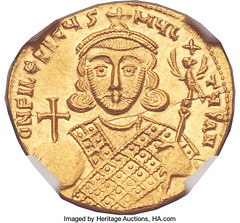
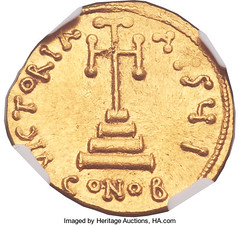
Philippicus (Bardanes) (AD 711-713). AV solidus (20mm, 4.44 gm, 5h). NGC Gem MS? 5/5 - 5/5. Constantinople, 10th officina. d N FIL?PIC?S-M?L-T?S AN, bust of Philippicus facing, wearing crown and loros, globus cruciger in right hand, scepter surmounted by eagle and star in left / VICTORIA-AVS? I, cross potent set upon three steps; CONOB below. Sear 1447. DOC 1. MIB 1. Rare! Minor obverse die break, otherwise an absolutely perfect specimen, crisply struck from fresh dies and fully lustrous. Quite likely the finest-known example!
Ex Lexington Collection of Jonathan K. Kern (Heritage Auction, NYINC 3037, 4 January 2015), lot 30988
Part of a debilitating string of short-lived rulers, Bardanes was a general of Armenian origins who was proclaimed Emperor upon the final overthrow of Justinian II. Almost immediately, he alienated the clergy and populace by reviving the Monothelete heresy (proposing that Christ had a single, divine nature and will) which had supposedly been stamped out decades previously. He was also unsuccessful in stopping Arab and Bulgarian advances, prompting the Byzantine army to depose and blind him after 18 months of ineffective rule. He was replaced by the finance minister Artemius, who reigned as Anastasius II. This extraordinary piece shows the unusually fine artistry employed on the coinage for so ephemeral a reign, showing the emperor holding two symbols of office dating back to Roman times: The globus cruciger and scipio aquila, a scepter topped by an eagle. The grade of Gem MS? is the highest possible grade assigned by NGC to an ancient coin.
Beautiful, high-grade piece. -Editor
To read the complete lot description, see:
Ancients:
Philippicus (Bardanes) (AD 711-713). AV solidus (20mm, 4.44 gm, 5h)
(https://coins.ha.com/itm/ancients/byzantine/ancients-philippicus-bardanes-ad-711-713-av-solidus-20mm-444-gm-5h-ngc-gem-msand-9733-5-5-5-5/a/3083-31040.s)
Lot 31075: Elizabeth I Gold Ship Ryal
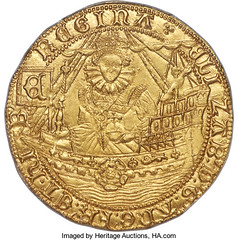
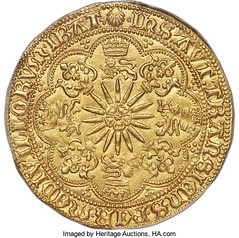
Elizabeth I (1558-1603) gold "Ship" Ryal of 15 Shillings ND (1584-1586) MS64 PCGS, Tower mint, Escallop mm, Sixth issue, S-2530, N-2004, cf. Schneider-785. 7.77gm. Absolutely spectacular, a piece whose very survival seems miraculous; one of the rarest and most popular coins of Elizabeth I's reign, absent from most British collections in any condition, yet preserved here to an unprecedented standard.
Every collector of hammered British gold will be familiar with this intensely sought-after issue, designed with charming medieval style imagery and Lombardic lettering. The Ryal was always a slightly controversial type, representing an attempt during Edward IV's first reign to simplify the confusion of circulating gold denominations by producing the equivalent of a 'Half Sovereign' worth 10 Shillings. However, as the Noble of 6 Shillings 8 Pence was by then the accepted standard, the Ryal was ultimately unsuccessful and replaced shortly afterwards by the famous Angel. Despite its initial unpopularity, the 10 Shilling Ryal reared its head once again in Henry VII's reign, and again in Mary's reign (then worth 15 Shillings to match the 30 Shilling Sovereign). By the time of Elizabeth's reign it was a far from necessary denomination and was produced solely for trade in the Netherlands, in a failed attempt to extract profit from the arbitrarily higher price Ryals traded for in the Low Countries.
To read the complete lot description, see:
Great Britain: Elizabeth
I (1558-1603) gold "Ship" Ryal of 15 Shillings ND (1584-1586) MS64 PCGS,...
(https://coins.ha.com/itm/great-britain/great-britain-elizabeth-i-1558-1603-gold-ship-ryal-of-15-shillings-nd-1584-1586-ms64-pcgs-/a/3083-31075.s)
Lot 31076: Charles I Gold Triple Unite
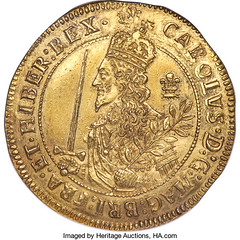
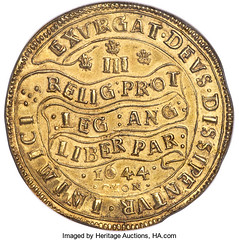
Charles I gold Triple Unite 1644 MS62+ NGC, Oxford mint, Plume mm, S-2729, N-2385, Brooker-841 (same dies). 27.00gm. Of utmost desirability and rarity, one of the finest extant examples of England's largest hammered gold coin produced in the early stages of the English Civil War of 1642-49. Highly sought after in any grade, the present piece represents the single second-from-highest graded example by NGC or PCGS, and combines this exalted preservation with undeniable medallic skill and fascinating numismatic history.
Prior to the war, Charles's coinage was almost uniformly poorly-struck, irregular-flanned and as crude as the contemporary Spanish 'pieces of eight'. Certainly, some experiments into milled coinage were being undertaken by Nicholas Briot, but in general Charles's coinage represents a very weak era for the output of the Royal Mint. However - this all changed once Charles left London and hostilities gradually began to take shape. Whilst numerous cities and towns began to declare their loyalty for either Royalists or Parliament, both sides proceeded to mint their own coins so as not to lose grasp of circulating currency and thus risk a breakdown of order. Indeed, coinage underpinned civilization to such an extent that even besieged castles and strongholds resorted to creating their own coins from salvaged plate silver. Parliament's coins were largely similar to the pre-existing regal issue, crudely struck and irregular. Charles, meanwhile, decided that coins were a perfect means of spreading his message and demonstrating his value - and thus he went on to produce exceptionally fine, large-sized pieces of gold and silver bearing his 'Wellington Declaration', stating to his people and Parliament that despite all appearances he upheld "the Protestant religion, the laws of England and the Liberty of Parliament".
Of all Charles's 'Declaration' coins, none are so impressive nor celebrated as the Triple Unite represented here in incredible Mint State. Many die varieties exist for this denomination, some rarer than others, but the present piece exhibits what is perhaps the most appealing and high-quality depiction of Charles; bearing a sword in his right hand and an olive branch in his left, the King holds both war and peace in his hands. Close inspection of the surfaces show a concerted effort for high-quality production, numerous die-polish lines yet no rust, evidence for a triple strike in the legends to fully render the intricately engraved devices. Deeply toned to a buttery aged-gold hue, faint sparkles of luster dancing under a mist of patina, every element of the strike crisp and presentable. The J. G. Brooker plate example of this same die pairing was offered in our August 2015 sale; graded AU58, that specimen realized $250,000. We are proud to host this far finer specimen, and do not doubt that is beauty, rarity and supreme quality will earn it a place in a world class collection of British gold.
Rare and always popular. -Editor
To read the complete lot description, see:
Great Britain: Charles I gold Triple Unite 1644 MS62+
NGC,. (https://coins.ha.com/itm/great-britain/great-britain-charles-i-gold-triple-unite-1644-ms62-ngc-/a/3083-31076.s)
Lot 31108: Grenada gold Counterstamped 66 Shillings
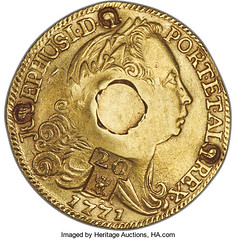
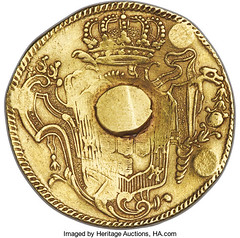
British Colony gold Counterstamped 66 Shillings ND (1798) VF, cf. KM2 (Rare; with stamped plug), Prid-19 (this coin), cf. Gordon-107. 30mm. 11.60gm. Struck over a contemporary counterfeit Brazil Jose I gold 6400 Reis 1771-R (cf. KM172.2 for official issue). Countermarks and host extremely fine. An intriguing piece, apparently double-regulated, first by the island of Grenada and later by the island of Martinique.
Following the proclamation by the President of Grenada on 31 July, 1798, Brazilian and Portuguese 6400 Reis (both authentic and forged) weighing at least 9.33gm were plugged with gold in order to raise their weight to a legal specification of 11.66gm so that they could legally pass as 66 Shillings. A margin of error among goldsmiths gave rise to slight variances, though this example is remarkably close to the mandated weight. The plug was then countermarked with the goldsmith's script initials: "IW," "WS," or "JR." Three incuse "G" countermarks were also spaced along the perimeters to prevent clipping, which may be observed on the present example. However, this particular piece is the only known specimen that lacks a countermark on the plug itself.
The addition of a second countermark below the central plug, that of an eagle below the numeral "20", all within a T-shaped indent, would indicate a later counterstamp under the authority of Martinique, following the regulation of 26 September, 1805 valuing these pieces at 22 Livres (cf. KM35). The relative dating of the the different countermarks is further supported by, upon close inspection, the very slightly finer state of preservation of this countermark in comparison to that of the Grenada countermarks and of the host.
Fascinating piece. -Editor
To read the complete lot description, see:
Grenada: British Colony gold Counterstamped 66 Shillings ND
(1798) VF,.. (https://coins.ha.com/itm/grenada/british-colony-gold-counterstamped-66-shillings-nd-1798-vf-/a/3083-31108.s)
ROMAN COIN HOARD FOUND IN HRUBIESZóW POLAND
Here's an article about a recent find of Roman coins in Poland. Found via The Explorator newsletter -Editor
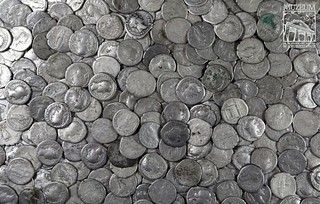 One of the
largest ever hauls of treasure from the Roman period to be found in Poland and the largest ever in the Lublin region has been uncovered in Hrubieszów near Lublin.
One of the
largest ever hauls of treasure from the Roman period to be found in Poland and the largest ever in the Lublin region has been uncovered in Hrubieszów near Lublin.
Excited archaeologists think that the treasure of 1,753 silver coins weighing over five kilos was abandoned in the last stand of the Vandals before fleeing from the arriving Goths at the end of the second century AD when Europe was in upheaval as the Western Roman empire was collapsing.
Andrzej Kokowski from the Archaeology Institute in Lublin, who discovered the presence of the Goths in the region, is in no doubt as to the scale of the find. “This is an amazing phenomenon of ancient culture that can be seen in one place. This treasure will be the crown of Polish archaeology,” he said.
The dinars are in the possession of the local museum in Hrubieszów, which released news of the find yesterday. However, the treasure was found in 2019 in a field near Cichobórz, south of Hrubieszów.
The coins were spread out over a field after being churned up by farm equipment. They were spotted by local farmer Mariusz Dyl, who was looking for abandoned antlers.
Dyl immediately informed staff at the museum in Hrubieszów about his discovery. Together they returned to the site and with a team of archaeologists and volunteers they discovered another 137 coins.
The coins were dated to the second century as they bear the image of Roman emperors Nerva, who ruled 8 November 30 to 27 January 98, and Septimus Severus, 11 April 145 to 4 February 211.
The coins will now be analysed by experts from the University of Warsaw, which will take about a year due to the size of the haul.
In the meantime, the museum wants to show the treasure to the public, but it says that due to the current epidemic the exhibition will be available only online.
To subscribe to The Explorator newsletter send a blank email message to: Explorator-subscribe@yahoogroups.com. -Editor
To read the complete article, see:
Crown of
Polish Archaeology! Farmer looking for abandoned antlers stumbles upon largest EVER haul of Roman coins
(https://www.thefirstnews.com/article/crown-of-polish-archaeology-farmer-looking-for-abandoned-antlers-stumbles-upon-largest-ever-haul-of-roman-coins-11621)
EXHIBIT: MEDIEVAL EASTERN MEDITERRANEAN COINAGE
An new online exhibit is available from the University of Richmond Museums. “A Pound of Whatever Silver He Pleases” features fifty-three coins from the eastern Mediterranean during the thirteenth and fourteenth centuries. Here's the announcement and a few selected coins. Check it out! -Editor
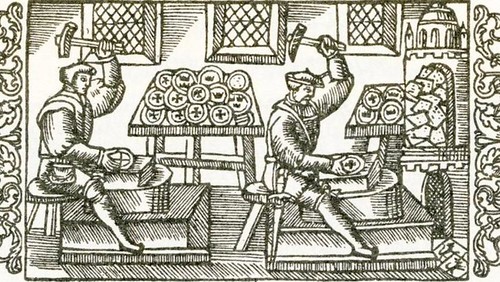
But in these things the money-changer is watchful so that he may buy a pound of whatever silver he pleases according to what returns a better profit to himself rather than to what will redound to the profit of the king - Hubert Hall Coinage was, in the Middle Ages, more than just currency. It was also a source of profit and power. As a result, coins from this period are particularly useful in understanding the interconnectedness of the medieval world and its various conflicts. Combining history and numismatics, this exhibition traces the political and economic developments of the thirteenth and fourteenth century eastern Mediterranean. Through a close examination of 53 unique coins, mostly in silver, from a number of the politically and economically important regional entities during the period, the exhibition utilizes monetary history to tell the story of the Mediterranean at a tumultuous point in its past.
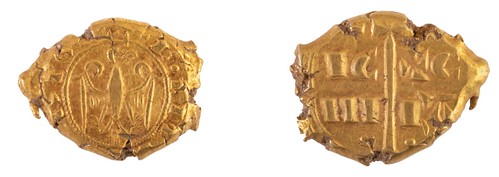
Two Tari: Friedrich II, der Staufer 1198-1250
The thirteenth and fourteenth centuries in the eastern Mediterranean were ones of profound shift for the region, which is reflected in the coinage. The conquest of Constantinople in 1204 by the soldiers of the Fourth Crusade marks the opening date of this study, as western European influence in the area rose to its height as a result. However, less than a century later, the Latin presence in the East was diminished through the fall of Acre and the loss of the Crusader States in 1291. Despite these political setbacks, the West still had a deep connection to the economy of the eastern Mediterranean, evident in the coinage of the time. The slow collapse of the Byzantine Empire, from the fall of Constaninople in 1204, to the recapture of the former capital in 1261, and even its harassment from the rising Turkish power in the region, materializes during this time. While these climatic events can be traced in other areas of study, the coinage of the Byzantine Empire from the period, while scant, informs on the profound impact of these calamities on the Empire. But, particularly for the Muslim world, this was a period of invasion. The entrance of the Mongols onto the political stage, as well as the decline and destruction of traditionally powerful political entities during these two centuries, marks a dramatic shift in the power structure of the Middle East. These changes are also made clear through the coinage of the period.
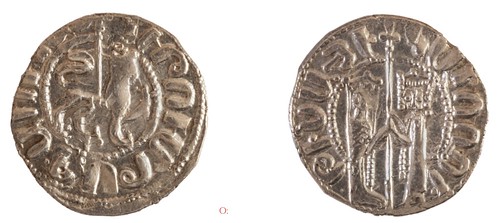
Tram: Het'um I and Zebel, Hetoumid 1226-1270
Coinage is often neglected when determining the history of a place or a power despite its real historical impact and its ability to formulate new narratives of the past. Coinage speaks on issues of politics or economy because of its role in trade, power projection, and art. Tracing the changes of this region through its coinage offers a fresh look at the eastern Mediterranean in the thirteenth and fourteenth centuries. While this collection does not claim to be all encompassing, these representative examples can shed light on the history of the region.
This exhibition was organized by the University of Richmond Museum, and curated by Mike Laposata, ‘20, History and Arabic Studies major and 2019-2020 Collections Assistant, University Museums with assistance from David Hershey, Assistant Collections Manager, University of Richmond Museums.
This exhibition is organized in honor of Joseph S. Laposata.
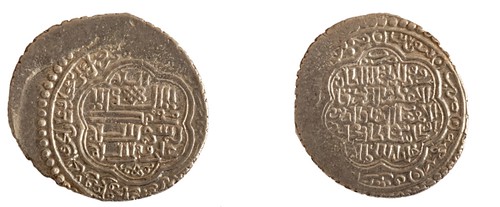
Six Dirhams: Öljeitü, Ilkhanid 1304-1316
To read the complete article, see:
"A Pound of
Whatever Silver He Pleases": History and Economy in the Late Medieval Eastern Mediterannean from the Lora Robins Gallery Coin Collection
(https://museums.richmond.edu/exhibitions/page.html?eventid=17625&informationid=casDataMuseumExhibition,startdate:2020-04-01,enddate:2021-12-31)
SCHOOL'S MUSEUM GAINS OFFICIAL RECOGNITION
David Sundman writes:"Here's a story of coins working their magic once again. Good thing we have our wonderful hobby to keep us company in this time of self-quarantine."
Indeed. Thanks for sending this. Here's an excerpt. -Editor
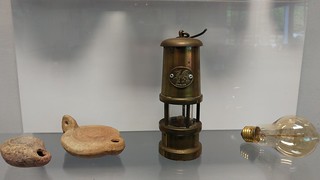 A school's collection of 200 artefacts
including ancient Roman and Greek coins and oil lamps and a fragment of Egyptian papyrus is the first of its kind to gain accredited museum status.
A school's collection of 200 artefacts
including ancient Roman and Greek coins and oil lamps and a fragment of Egyptian papyrus is the first of its kind to gain accredited museum status.
The Rumble Museum at Cheney School, an academy in Headington, Oxford was founded in 2013 to boost students' interest in the Classics and has now been recognised by Arts Council England.
This means it can more easily apply for grants to help develop its collection and can enter into partnerships with other museums and galleries.
The museum is the brainchild of Lorna Robinson, who teaches Latin and Classical civilisations at the school and founded its community Classics centre, which offers free classes and talks to local people.
Artefacts, many of which have been donated, are catalogued by students who curate the displays that are spread across the school. Some items such as ancient coins are brought out for handling in lessons. Highlights include a silver tetradrachm coin of ancient Athens depicting Athena on one side and the goddess's owl with an olive sprig and crescent moon on the other. The coin was worth about four times the daily wage of a skilled worker or soldier.
She said: “Objects can be really special — seeing an object in front of you can be very different to reading about it in a book or seeing a photograph. There's also the magic of knowing that you're holding something that was also held by a Roman 2,000 years ago, for example.”
To read the complete article (subscription required), see:
It's history in the making as Cheney School's
museum gains official recognition (https://www.thetimes.co.uk/article/its-history-in-the-making-as-cheney-schools-museum-gains-official-recognition-czs99sdmw)
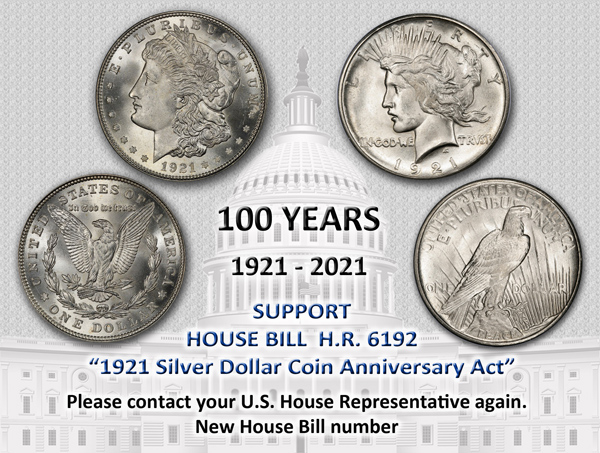
WILLIAM JAMESON – AN UNLIKELY MINT DIRECTOR
Dale Seppa has adapted an article from A Numismatic History of Ecuador by Michael J. Anderson about William Jameson, the unlikely Director of the Quito mint in Ecuador. I've read the full version, and it's very interesting. For a free copy, contact Dale. -Editor
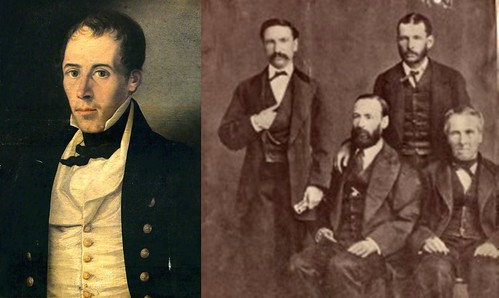
Left: Original painting by Antonio Salas, Quito, 1842. Photo of the original used with permission of the Board of Trustees of the Royal Botanic Gardens, Kew. Right: Jameson with his three sons in Argentina. Standing; Tomas and Juan Jameson-Olivero. Seated ; Guillermo Jameson-Olivero and William Jameson. Photo was taken in 1870 at the photographic studio of Grandin and Metaine in Mendoza.
William (Guillermo) Jameson – An Unlikely Mint Director
The initials “G.J.” prominently displayed on Ecuadorian coins dated from 1832 through 1862 are the assayer's mark of William (Guillermo) Jameson the chief assayer of the Quito mint in Ecuador. Jameson was later the Mint Director. His background and inclination for that office was about as unlikely as can be imagined.
The seven page article is rather interesting. Dale Seppa is planning on putting it in its entirety in his next price list of Ecuadorian coins. Any interested party can write Dale at daleseppa@gmail.com for a copy of that list or a PDF of the article alone.
With exception of the addition of the photos and a few additional details this article is condensed from Appendix I of A Numismatic History of Ecuador by Michael J. Anderson, M.A., F.S.A., F.R.N.S., with his kind permission. The original Appendix includes much more information, particularly botanical and genealogical as well as extensive footnotes for those interested in greater detail.
U.S. MINT PATENTS METAL ALLOY FOR COIN PRODUCTION
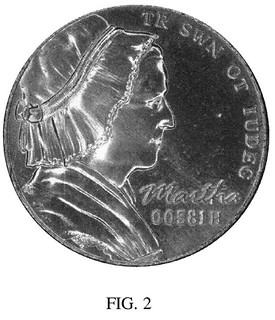
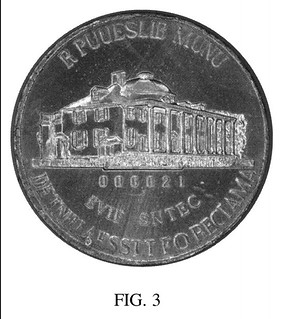
Images from U.S. Patent No. 10,472,703
My Nummis Nova friend Steve Bishop located a U.S. Mint patent I'd recently heard about. Thanks. Here's an excerpt. It includes images of "Martha" test designs. -Editor
The metal alloy is a possible replacement for/alternative to cupronickel cladding material used on currently-circulating clad coins. In the preferred embodiment, the (steel) metal alloy cladding material comprises 73-77% iron, 22-26% nickel, 0.2-0.5% carbon, and 1-5% manganese. The cladding material has an International Annealed Copper Standard (IACS) conductivity of less than 2%, a permeability of approximately 1.0-1.1, and a hardness value of 50-70 HRC 15 T (Rockwell Hardness). In alternative embodiments, the steel alloy comprises a monolithic coin or a core that may be plated with other metals.
FIELD OF THE INVENTION
The disclosed alloy comprises a cladding material for making coins. Specifically, the disclosed steel alloy comprises a coinage material that is suitable for use as an alternative
cladding for currently-circulating US coins.
BACKGROUND OF THE INVENTION
Over time, the value of some coin materials have increased to be worth more than the face value of the coins. Steel is an attractive alternative material for replacing some
current coin alloys—primarily because of steel's low cost and excellent durability. The current price of steel is only about 1/10 to 1/15 of the price of copper. However,
steel has a high permeability (i.e. degree of magnetism) and other problematic electrical and surface-hardness properties. Specifically, steel's lag phase angle is completely
different from non-ferromagnetic materials. Consequently, existing coin validators will not recognize (for example) a steel quarter—even though the steel quarter may have the same
dimensions and stamping as currently-circulating quarters
However, some steel alloys are non-ferromagnetic and have significantly different properties than common steel. To use most steels, stamping tonnage must be increased by more than 20% (relative to copper or cupronickel) to achieve a clean stamping relief result. To be usable, a steel coin must have low strain hardening properties (i.e. be sufficiently soft) for effective stamping, and have a relative permeability that is close to 1.0. A relatively high nickel-steel coin can meet these criteria. If steel containing 18% nickel and 0.60% carbon is quenched in water, the material will be perceptibly softened. If the amount of nickel is raised to 25%, this softening is even more apparent. Generally, as the amount of nickel increases, the steel softens, and a 25% nickel steel can be worked cold almost as easily as German silver or cupronickel.
The need exists for a replacement alloy material that is less expensive and more durable (among other things) than the cupronickel coin cladding material that is currently in use. As described herein, the inventors determined that, by manipulating various steel alloys, a nickel steel alloy could be identified and developed for use as an alternative coin cladding material for coins such as US dimes, quarters, half dollars, and dollar coins. The material described herein meets that criteria and is compatible with coin validator/acceptor machines currently in use.
SUMMARY OF THE INVENTION
This disclosure is directed to a steel alloy to be potentially used as cladding material for new US coins. The cladding material described herein is an alternative to the existing
cupronickel cladding on currently-circulating US coins. In the preferred embodiment, the cladding material described herein comprises 73-77% iron, 22-26% nickel, 0.2-0.5% carbon,
and 1-5% manganese. The cladding material has an International Annealed Copper Standard (IACS) conductivity of less than 2%, a relative permeability of approximately 1.0-1.1, and
a hardness value of 50-70 HRC 15 T (Rockwell Hardness).
Steve adds:
"The patent says that the alloy could also be used as a monolithic blank that could be plated."
There have been many attempts over the years to create new materials for coins, but only a small portion succeed and end up in production. Time will tell what happens with this alloy, if anything. -Editor
For the complete U.S. Mint patent, see:
Metal Alloy for Coin Production (https://patents.justia.com/patent/10472703)
http://www.freepatentsonline.com/10472703.pdf
GERMS AND MONEY
David Pickup submitted these notes about germs and money. Thanks! -Editor
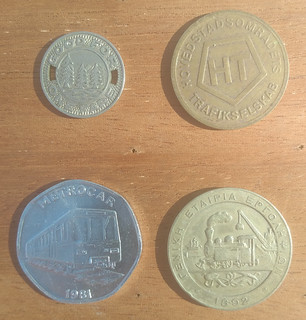 On 29th September 1891 The Huddersfield Daily
Chronicle carried a story about a doctor from San Francisco who had been warning of the dangers from coins. He commented on people who put a coin between their lips when
getting into a tramcar. Presumably they needed to have their fare ready. He asked whether people ever think, “Where a coin may have been”. He had known cases of coins being used
to close the eyes of people who had died from leprosy. “Bright as it is, money carries on its face the germ of many a disease…”
On 29th September 1891 The Huddersfield Daily
Chronicle carried a story about a doctor from San Francisco who had been warning of the dangers from coins. He commented on people who put a coin between their lips when
getting into a tramcar. Presumably they needed to have their fare ready. He asked whether people ever think, “Where a coin may have been”. He had known cases of coins being used
to close the eyes of people who had died from leprosy. “Bright as it is, money carries on its face the germ of many a disease…”
I was always told not to hold things in your teeth such as pencils as there is a danger of accidentally knocking your teeth out. I have never actually met anyone who has had this happen. I cannot say I ever hold coins in my mouth. There would be an unpleasant taste for one thing and if someone pats me on the back to show what as fine chap I am in danger of swallowing my tram fare. (Trams will feature quite a lot in this piece).
On 3rd January 1893 The Standard published a letter from a L.M. D'Orsey who was worried he would get cholera from dirty coins. He said pennies in particular were often “absolutely filthy”. He suggested local authorities set up disinfecting units and people could exchange dirty for cleaned coins. An early form of money laundering.
On 11th July 1913 the Manchester Courier and Lancashire General Advertiser carried a story from a French paper that nickel coins were most sterile. A square centimetre of a nickel coin has a hundred and forty thousand microbes but a copper coin was much dirtier. Money the article pointed out is truly the root of all evil. Every man would have “death in his pocket” as he could not be expected to write a cheque every time he goes on a tram.
The Dundee Courier on 28th November 1932 quoted a doctor as saying a man's pockets were full of dirty things including coins and banknotes. Pockets are hardly ever turned out or cleaned. The doctor suggested abolition of pockets! He was Dr Percy Edgelow from London. The idea did not catch on!
The only positive health note was on 3rd May 1920 when the Nottingham Evening Post, under the heading “Filthy Lucre” the paper reported on an experiment by the Department of Public Health in New Zealand. They used coins given in change on tramcars and found some bacteria but only the ones that would normally be found on human skin. They then tried out various bacteria but after four hours found there was no bacterial growth. The scientists suggested the metal killed the germs.
Keep well!
These articles show that the debate over the safety of handling money is age-old and will likely never be resolved to anyone's satisfaction because everyone has a different perception and tolerance of risk. As an engineer I pay attention to the scientists and the probabilities they assign to the risk. I don't like the idea of getting sick or dying any more than anyone else, but I know I do have a higher threshold for risk because many people have ZERO tolerance - they don't want ANY risk, no matter how small. The more studies they see the more scared they become. Emotion takes over and any nonzero risk seems intolerable. And in times like these, who can blame them?
The comedian George Carlin had a great routine on "Germs" (look for it on streaming audio apps). It starts with the "germ" of an idea and pushes it to ridiculous extremes, which is the essence of great comedy. In making fun of germaphobe culture he pushes the limits of risk tolerance through the roof and beyond. Before coronavirus it was funny as hell. Now, not so much. -Editor
HISTORY OF MONEY CLEANING
Ron Haller-Williams submitted these notes on "money laundering" in history. Thanks! -Editor
During the plagues of the 14th to 17th centuries, bowls (or hollowed stones) filled with vinegar were used to decontaminate the "filthy lucre", so that infection could not get passed on via money; banknotes were not in general use in those days!
"Money has no smell" ("Pecunia non olet", apparently from the emperor Vespasian. i.e. The value of money is not tainted by its origins. (But the trouble is that most money IS tainted - 'tain't yours and 'tain't mine!!!)
Posted on March 31st, the video "Lavando o dinheiro" ("washing money" or "money laundering") has a fairly quiet soundtrack, in Brazilian Portuguese, including the sentence "Un homen foi preso por lavagem de dinheiro" ("A man was arrested for money laundering")
I must admit that I've done a bit of this to improve the appearance of a few banknotes for my collection.
And, as if to prove Vespasian wrong, it was reported in May 2019 that "money with the smell of "Marijuana" sent some people to prison. Apparently the equivalent of about US$25,000 was deposited, but it smelled of "wacky 'baccy" (as some people call it), and this led to the arrests. If you look at the automatic translation (last link), please note that the Portuguese word "laranja" means "orange", but also "front" or "mule etc - a third party who is used in place of the real person involved.
Links:
Lavando o dinheiro (https://www.youtube.com/watch?v=l2pnCI978nE)
Dinheiro com cheiro de maconha
leva polícia a descobrir esquema de lavagem
(https://g1.globo.com/jornal-nacional/noticia/2019/05/25/dinheiro-com-cheiro-de-maconha-leva-policia-a-descobrir-esquema-de-lavagem.ghtml)
"Marijuana-smelling
money takes three people to prison in Curitiba"
(https://translate.google.com/translate?hl=en&sl=pt&u=https://www.gazetadopovo.com.br/curitiba/operacao-investiga-dinheiro-com-cheiro-de-maconha/&prev=search)
Ron's Vespasian note is based on an interesting Wikipedia article. Because of the Russian tokens we numismatists are familiar with the "beard tax". How about the "urine tax"? -Editor
A tax on the disposal of urine was first imposed by Emperor Nero under the name of “vectigal urinae” in the 1st century AD. The tax was removed after a while, but it was re-enacted by Vespasian around 70 AD in order to fill the treasury.
Vespasian imposed a Urine Tax (Latin: vectigal urinae) on the distribution of urine from public urinals in Rome's Cloaca Maxima (great sewer) system. (The Roman lower classes urinated into pots which were emptied into cesspools.) The urine collected from public urinals was sold as an ingredient for several chemical processes. It was used in tanning, wool production, and also by launderers as a source of ammonia to clean and whiten woollen togas. The buyers of the urine paid the tax.
The Roman historian Suetonius reports that when Vespasian's son Titus complained about the disgusting nature of the tax, his father held up a gold coin and asked whether he felt offended by its smell (sciscitans num odore offenderetur). When Titus said "No", Vespasian replied, "Yet it comes from urine" (Atqui ex lotio est).
The phrase Pecunia non olet is still used today to say that the value of money is not tainted by its origins. Vespasian's name still attaches to public urinals in France (vespasienne) and Italy (vespasiano).
To read the complete article, see:
Pecunia non olet (https://en.wikipedia.org/wiki/Pecunia_non_olet)
THAILAND ISSUES NEW COINS TO CURB CORONAVIRUS
Here's an article about Thailand's response to dirty money. Thanks to Pabitra Saha for passing this along. -Editor
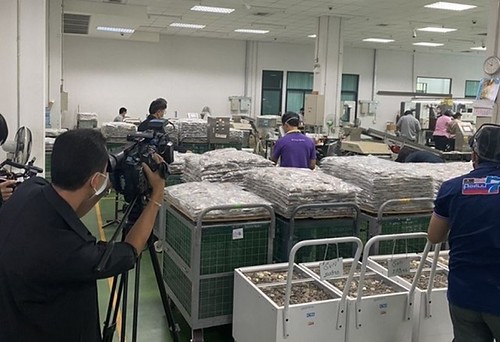
Visiting the Rangsit Mint, Yuttana Yimgarund, director-general of the department, said the department focused on releasing new coins for public confidence amid concerns on the virus pandemic.
He said that COVID-19 stayed with old coins for 5-7 days and with banknotes for 9 days.
The department collected old coins and banknotes and completely sanitized them with ultraviolet light at 200 degrees Celsius. “After receiving coins from customers, vendors can simply wash them with detergent and dry them in sunlight or clean them with alcohol… Besides, people can make payments through online channels and money transfers,” Mr Yuttana said.
The Treasury Department was releasing 31 billion coins in the country and they were enough for local use, he said. (TNA)
To read the complete article, see:
Thailand's Treasury Dept. releases new coins to curb
coronavirus (https://www.pattayamail.com/business/thailands-treasury-dept-releases-new-coins-to-curb-coronavirus-293880)

SAM ALFANO'S SHERLOCK HOLMES HOBO NICKEL
Greg Ruby's blog The Fourth Garrideb - Numismatics of Sherlock Holmes recently featured an article about Hobo Nickel carver Sam Alfano. -Editor
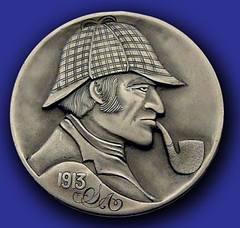 Today, we are
featuring this 1913 Buffalo nickel that has been engraved by Sam Alfano of Louisiana. His biography, from his Master Engraver website, offers up this capsule:
Today, we are
featuring this 1913 Buffalo nickel that has been engraved by Sam Alfano of Louisiana. His biography, from his Master Engraver website, offers up this capsule:
Sam Alfano began engraving in the early '70's with a set of engraving tools purchased from a mail order catalog. He experimented with engraving on and off for a few years, but didn't get serious about the craft until 1979. The few engravers he'd met were unwilling to share their knowledge of tool sharpening, engraving technique, etc., and learning was a slow process.
In 1982, Stanley Diefenthal, of the famed New Orleans Arms Co., hired Sam on a full time basis to engrave guns in his personal collection. Since engraver Lynton McKenzie had worked there for many years, Diefenthal brought McKenzie in to train Sam. For the first time, Sam was afforded the opportunity of professional instruction, not to mention studying under one of the world's great engravers, and assumed McKenzie's place at the engraving bench at New Orleans Arms Co.
In 1984, Sam traveled to Brescia, Italy to learn techniques of banknote or “bulino” engraving from the great Firmo Fracassi. He continued to work for New Orleans Arms Co. until 1989 when Diefenthal passed away.
Once on his own, Sam focused his attention on handmade knives and high-end jewelry engraving.
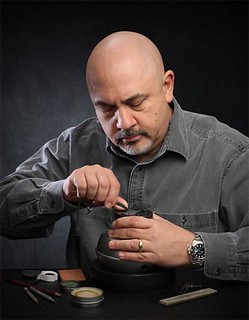 Sam has continued to work on custom knives and
jewelry, catering to advanced collectors in many countries, and has produced some of the finest engraved pieces made. He is best known for his intricate designs, precise detail,
and flawless execution of this demanding art form, and his work has been featured in books and magazines around the world.
Sam has continued to work on custom knives and
jewelry, catering to advanced collectors in many countries, and has produced some of the finest engraved pieces made. He is best known for his intricate designs, precise detail,
and flawless execution of this demanding art form, and his work has been featured in books and magazines around the world.
He is a certified Master Engraver by the Firearms Engravers Guild of America, and is also an accomplished musician, photographer, member of Mensa, engraving instructor for GRS, and has demonstrated hand engraving and diamond setting techniques in Germany, Belgium, Sweden, France, Hong Kong, Switzerland, Italy, China, Japan, Thailand, and the USA. In addition to engraving, Sam's graphics illustrations are in use worldwide on thousands of products from book covers to clothing, and he has authored several instructional engraving videos.
There are a large number of his engraving videos available on YouTube, if you would like to see further examples of his caring and engraving skills.
It appears that this particular Sherlock Holmes engraved nickel was done in early 2014 or possibly earlier, based on dates this nickel first started showing up online. Truly, a magnificent piece of engraving!
To read the complete article, see:
Sam Alfano's Sherlock Holmes Hobo Nickel
(https://fourthgarrideb.com/2020/03/31/sam-alfanos-sherlock-holmes-hobo-nickel/)
1867 MONTGOMERY ANTICIPATION NOTES
Here's an excerpt of an article by Bill Gunther in the March/April 2020 issue of Paper Money from the Society of Paper Money Collectors (SPMC). Editor Benny Bolin kindly forwarded the text and images at my request. Thanks! -Editor
Financing Government During Reconstruction: The County of Montgomery (Alabama) and their Revenue (Tax) Anticipation Notes of 1867
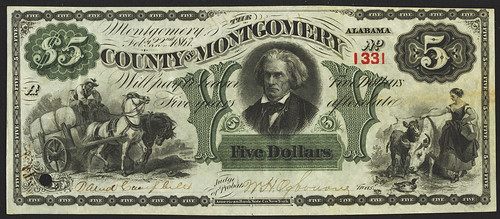
Immediately after the Civil War (April 1865) states, cities and counties throughout Alabama found themselves bankrupt and without a major source of revenue. Confederate and Alabama paper money that circulated during the war was now worthless. Even if there was some “money”, shortages of manufactured goods, medical supplies as well as food drove prices beyond reach by most residents. Food was scarce due to the absence of the men who would have tilled and planted the crops and much of the existing food supply had been diverted to the military. It was estimated that as a result of these shortages, “a typical Southern family's food bill was $6.65 per month at the time of secession and $400 a month in 1864.”
While the tax base in many areas of the South was destroyed during the war, such destruction was minimized in the City of Montgomery. Local businessman, John Robert Powell, and others “...joined the Mayor and a group of leading citizens who rode out to meet the enemy and presented (Union) General Wilson the unconditional surrender of the city.” This act of surrender, as well as the good behavior of the Union troops in Montgomery, is credited with allowing the city to escape major war damage.
How to Pay for the Reconstruction
With no tax base and support from the Federal government slow to arrive with adequate assistance, finding ways to raise local government revenues was a difficult task. A partial
solution, adopted by many cities and counties, was to pay their obligations with post-dated notes. These “Post Notes” as they were called, stated (often obscurely) a redemption
promise sometime in the future (e.g., six months). For example, the County of Montgomery issued $1 notes payable in one year, and $2 and $5 notes payable in five years. It was
“anticipated” that by the due dates of these notes, the economic condition of the state would have improved to the point where revenues would allow the redemption of these notes.
Since none of these notes paid interest there was little incentive to hold on to them. The fact that the notes were “receivable in payment of county dues” may have made them
acceptable and they may have circulated like “money” by local residents.
“Revenue Anticipation Notes”
Today, these notes might be compared to “Revenue Anticipation Notes” or even “Tax Anticipation Notes”. The private sector engaged in such financing during the time leading up to
the Civil War through the use of what were called “Post Notes” by the issuer.
The notes from the County of Montgomery do not use the words “Post Notes” but the term would clearly apply. They were printed by the American Bank Note Company. Henry Clay appears on the $1, Daniel Webster on the $2 notes while the $5 contains the image of John C. Calhoun. All of the notes carry the printed issue date of February 22, 1867.
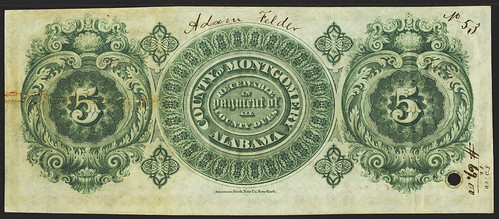
For more information on the Society of Paper Money Collectors, see:
https://www.spmc.org/
ANA BEBEE COLLECTION'S UNCUT SHEETS CERTIFIED
This press release highlights a rare and interesting uncut sheet from the Bebee collection at the ANA. -Editor
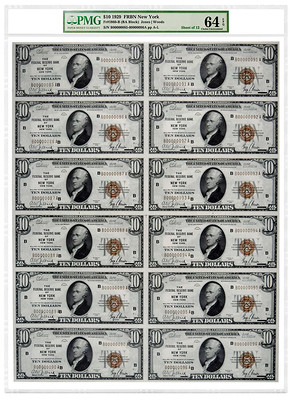
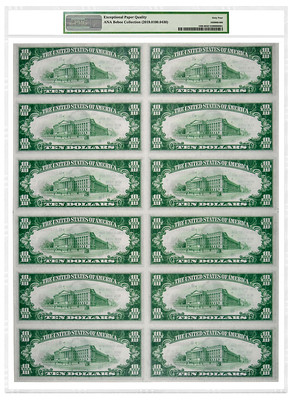
Paper Money Guaranty® (PMG®) was honored to recently certify nearly 20 uncut sheets of banknotes from the legendary ANA Bebee Collection. The sheets were submitted to PMG by the American Numismatic Association (ANA), the country's largest nonprofit numismatic organization, which received the Bebee Collection in 1988.
Banknotes are printed in sheets that are then cut into individual notes for circulation. Uncut sheets of vintage US banknotes are exceedingly rare as typically only a handful were saved for presentation purposes.
The ANA submitted the uncut sheets to PMG, its official paper money grading service, so that they could be protected for future generations by the latest PMG holder. Introduced in 2016, the current PMG holder is comprised of high-quality inert materials that provide superior optics and long-term preservation. Each sheet is encapsulated with a PMG certification label that identifies its description, grade and provenance.
One especially impressive piece that PMG graded from the ANA Bebee Collection is an uncut sheet of 12 1929 $10 Federal Reserve Bank Notes (New York) attributed as Fr#1860-B. Graded PMG 64 Choice Uncirculated EPQ, it is one of only two known sheets.
Although dated 1929, these notes were actually issued in March 1933 during a government-mandated nationwide bank holiday. The economic downturn that triggered the Great Depression had hit rock bottom, resulting in panic withdrawals from US banks. Just two days after his inauguration, President Franklin D. Roosevelt ordered the suspension of all banking transactions to prevent banks from failing entirely.
Upon the banks' reopening, Treasury officials decided to issue banknotes backed by the sound assets of the banks — as opposed to issuing currency backed by gold — which meant new currency, indicating such, needed to be produced quickly.
Thus, the emergency cash was printed from hastily revised plates. Older notes are described at the top of the bill as “National Currency Secured by United States Bonds Deposited with the Treasurer of the United States of America.” The new issue bears the additional phrase “or by like deposit of other securities.”
Numismatists can view and study these historically significant notes thanks to Aubrey and Adeline Bebee.
The Bebees are among the most esteemed collectors in the history of numismatics. They collected important US and world coins, including their famous 1913 Liberty Nickel (which many believe kick-started the high-end coin market), but the Bebees' foremost collecting interest was American paper money.
When the Bebees began assembling their paper money collection in 1941, note collecting was not considered prestigious or important. Indeed, paper money collectors were called “ragpickers” — and not affectionately. The Bebees changed all that when they focused their attention on collecting banknotes.
While paper money collecting did not have much cachet, it did allow the Bebees to purchase the highest quality notes for only a moderate premium over face value. In today's market, many of these notes would sell for tens of thousands of dollars more, and pedigrees in the collection basically comprise a hobby hall of fame.
The many spectacular rarities in the ANA Bebee Collection include a 1934 $10,000 Federal Reserve Note and an almost complete type set of large-size US currency in all denominations from $1 to $100. The more than 800 individual notes in the collection were previously certified by PMG between 2010 and 2015.
In addition to being a keen collector, Aubrey Bebee was a major dealer. As a dealer, he was a leader in efforts to upgrade the ethics of the marketplace. His own business was known for exceptional quality and service, and he was one of the organizers of the Professional Numismatists Guild (PNG), becoming Charter Member No. 1 in 1955.
The ANA recognized the Bebees' numismatic efforts and achievements many times. In 1968, Aubrey Bebee was awarded the Medal of Merit in recognition of years of service to the hobby. In 1988, the Bebees were chosen as joint recipients of the Farran Zerbe Memorial Award, the ANA's highest honor, and they received the Lifetime Achievement award in 1992. Aubrey Bebee passed away the same year.
“The Bebees were pillars of 20th century numismatics, and their extraordinary impact on the ANA and the hobby continues to be felt to this day,” said Kim Kiick, ANA Executive Director. “We are very pleased that their incomparable collection of banknotes is now completely safeguarded and preserved by the state-of-the-art PMG holder.”
Mark Salzberg, PMG Chairman, added, “Numismatists dream of being the type of collectors that the Bebees were — perceptive, bold and generous. They were truly ambassadors of the hobby, and PMG is honored to help the ANA preserve their collection.” The Bebees donated their collection to the ANA in 1988, and examples from it rank among the ANA Museum's premier attractions. The ANA Bebee Collection notes are also featured in Paper Money of the United States by Arthur L. and Ira S. Friedberg, the standard reference book on American currency.
The Bebees were longstanding contributors to the book, and now their collection deservedly has a permanent place in it.
To view a gallery of the Bebee Collection, visit ANA-Museum.org.
ARTISTS USING MONEY AS A METAPHOR
We've often discussed the work of "money artists" such as J.S.G Boggs, Mark Wagner and others. Andy Warhol , Marcel Duchamp and others before them also explored this territory. Here's an excerpt from a March 24, 2020 ARTnews piece, "A History of Artists Using Money as a Metaphor—and a Medium in Their Work". -Editor
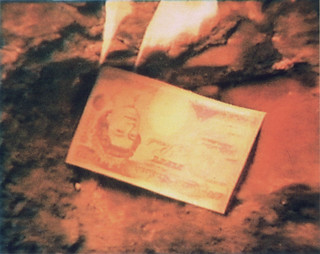 It's tough out there for artists! Burn all
your hard-earned money, and people get upset. Mint a small fortune through a clever gimmick, and the results are the same. But never mind. The burning bills, the sunken gold, and
the immodestly priced banana are just three particularly extreme examples of a mode of art at least a century old that takes money as its medium—literally or figuratively.
It's tough out there for artists! Burn all
your hard-earned money, and people get upset. Mint a small fortune through a clever gimmick, and the results are the same. But never mind. The burning bills, the sunken gold, and
the immodestly priced banana are just three particularly extreme examples of a mode of art at least a century old that takes money as its medium—literally or figuratively.
Call it Money Art.
In 1939, critic Clement Greenberg argued that the avant-garde was connected to the ruling class of society by an “umbilical cord of gold.” Money Art often focuses on that cord with a gimlet eye. In a time defined by the commodification of art—recently minted paintings showing up on the auction block, seven-figure prices for artists barely 30 years old—Money Art questions the churning operation of the art industry. It harnesses streams of cash for new ends and lets viewers see finance operating with often startling clarity.
Damien Hirst's diamond-bedecked skull, For the Love of God (2007), is classic Money Art, since its price tag—a cool £50 million, or about $100 million at the time—is a key component of the piece. (Not to mention its markup from the reported £12 million spent to make it.) Richard Prince's more aggressively appropriative works—like those reproducing with only minor alterations the work of professional photographers—also count, given that part of their menacing appeal owes to the looming sense that they are backed by a willingness to litigate at length (another form of burning money). So, too, are certain new cost-intensive sculptures by Jeff Koons, whose financial structures—as documented in recent lawsuits—have the intricacy of real estate deals.
While the more splashy, crass works of Money Art grab headlines, a whole secret history of 20th-century art can be written about more nuanced and oblique approaches to the form. These are works that consider and challenge the ways that money operates in contemporary society as a source and symbol of power and shame, and as a tool for exchange.
As with movements of so many other kinds, Marcel Duchamp is a pillar of Money Art. For his 1924 work Monte Carlo Bond he advertised a series of bonds by which he claimed he would exploit a system he had developed to make money while at the roulette wheel in Monaco. The details of the enterprise are hazy, but he reported to friends that, over countless hours of spinning, “I'm neither ruined nor a millionaire and will never be either one or the other.” That's about all that most artists hope for, at the end of the day.
To read the complete article, see:
Hard Cash: A History of Artists Using Money as a Metaphor—and a Medium in Their
Work (https://www.artnews.com/art-news/artists/money-medium-artwork-history-1202680319/)
LOOSE CHANGE: APRIL 5, 2020
Here are some additional items in the media this week that may be of interest. -Editor
The Phillips Collection and the Healing Power of Art
Also from ARTnews comes this non-numismatic piece about a current topic - a great museum founded in response to a pandemic death. -Editor
The world is currently facing unprecedented challenges, and the arts can provide a measure of relief. Now that we are unable to interface with our communities physically, we in the field need to be thoughtful about how we move the wellness aspects of the museum experience online. Recently there has been a movement towards thinking of museums as places of solace and meditation, and this is something we need to continue to focus on beyond the Covid-19 crisis. But it is often assumed that this is something new. The institution I lead, the Phillips Collection in Washington D.C., is proof that art has been associated with wellness long before the current focus on this connection.
The Phillips Collection, however, from its very inception focused on the healing power of art. Nearly a century ago, in 1921, Duncan Phillips established the Phillips Memorial Gallery, a place of solace and a memorial to his father who died in 1917 and brother, James Laughlin Phillips, who succumbed to the Spanish influenza epidemic in 1918. The museum was founded on the principles of the deep connection between art and wellness, with Duncan Phillips determined to create a collection of art for the community.
“There came a time when sorrow all but overwhelmed me,” Phillips wrote in his 1926 book A Collection in the Making: A Survey of the Problems Involved in Collecting Pictures Together with Brief Estimates of the Painters in the Phillips Memorial Gallery. “Then I turned to my love of painting for the will to live?…?So in 1918 I incorporated the Phillips Memorial Gallery, first to occupy my mind with a large, constructive social purpose and then to create a Memorial worthy of the virile spirits of my lost leaders—my father?…?and my Brother?…. I saw a chance to create a beneficent force in the community where I live—a joy-giving, life-enhancing influence, assisting people to see beautifully as true artists see.”
To read the complete article, see:
Op-Ed: This Art Museum Was Founded in Response to a Pandemic Death. It Has
Much to Teach Us Now. (https://www.artnews.com/art-news/news/phillips-collection-pandemic-art-wellness-1202683082/)
Coins in Shakespeare
Mike Markowitz published a nice article for CoinWeek on the coins of Shakespeare. Here's an excerpt, but be sure to see the complete article online. -Editor
William Shakespeare (1564–1616) was born in the 31st year of the reign of Elizabeth I (ruled 1533–1603) and died in the 13th year of the reign of James I (ruled 1603-25). England's circulating coinage during his lifetime included 11 different denominations in silver and nine in gold (there was no copper), along with many French, Italian, Spanish, and Dutch types mentioned in the plays.
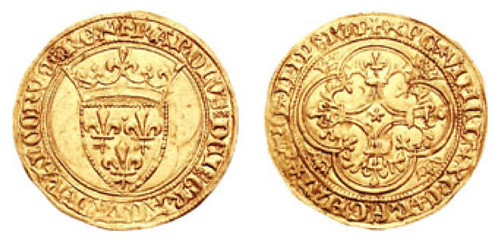
"Indeed, the French may lay twenty French crowns to one they will beat us … But it is no English treason to cut French crowns, and tomorrow the king himself will be a clipper."
—Henry V, Act IV, scene 1
“French crown” was the English name for a gold coin, the ecu à la couronne (“shield with a crown”) issued from 1385 to 1640. The weight and value varied over time. The obverse bore France's royal coat of arms, a shield with three lilies (fleurs-de-lis) topped by a crown. The reverse bore an elaborate “floreate” cross, surrounded by a Latin inscription: “Christ conquers, Christ reigns, Christ rules.”
Clipping the edges of gold coins in order to sell the clippings was an illegal, but common, medieval practice. Clipping coins bearing the king's image was punishable as treason.
To read the complete article, see:
Mike Markowitz: The Coins of Shakespeare
(https://coinweek.com/world-coins/mike-markowitz-the-coins-of-shakespeare/)
Gold Coins of Charles I
Here's a blog article from Baldwin's on coins of Charles I, the second Stuart King. -Editor
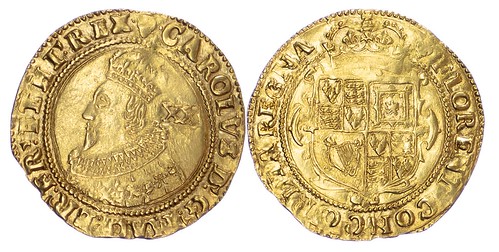
Charles I was King of England, King of Scotland, and King of Ireland from 27 March 1625 until his execution in 1649. He was born into the House of Stuart as the second son of King James VI of Scotland. After his father inherited the English throne in 1603 as James I, he moved to England. After the death of his older brother Henry Frederick in 1612, he became heir apparent to the three kingdoms. Charles I ascended to the throne in 1625, the same year he married the Bourbon princess Henrietta Maria of France, who was a Roman Catholic.
The gold Unite denomination was first produced during the reign of King James I and named after the legends on the coin that indicated the king's intention of uniting the two kingdoms of England and Scotland. Numerous issues of gold unites, valued at twenty shillings, were produced at the Tower Mint throughout the reign of Charles I, both when the mint was under the king's control and later when it was under the control of the Parliament.
To read the complete article, see:
GOLD COINS OF KING CHARLES I (https://www.baldwin.co.uk/news/gold-coins-of-king-charles-i/)
More on the 1921 Silver Dollar Coin Anniversary Act
Lou Golino published a new article for Coin Update discussing how collectors are reacting to the new 2021 silver dollar legislation and includes some key clarifications about what is being proposed. Here's an excerpt, but be sure to see the complete article online. -Editor
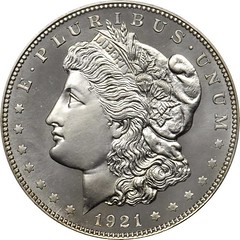 ... a new approach to
issuing Morgan and Peace silver dollars in 2021 took root when H.R. 6192, the 1921 Silver Dollar Coin Anniversary Act, was introduced by Rep. Andy Barr (R-KY06). It has 17
original co-sponsors who supported the bill as of the day it was introduced — a much stronger debut than last year's legislation, H.R. 3757. Unlike a commemorative coin bill, this
one could pass with a simple majority — a much more accessible goal than the two-thirds of each house of congress required as co-sponsors for commemorative coin programs.
... a new approach to
issuing Morgan and Peace silver dollars in 2021 took root when H.R. 6192, the 1921 Silver Dollar Coin Anniversary Act, was introduced by Rep. Andy Barr (R-KY06). It has 17
original co-sponsors who supported the bill as of the day it was introduced — a much stronger debut than last year's legislation, H.R. 3757. Unlike a commemorative coin bill, this
one could pass with a simple majority — a much more accessible goal than the two-thirds of each house of congress required as co-sponsors for commemorative coin programs.
The new proposal seeks the issuance of Morgan and Peace silver dollars to mark the centennial of the transition in 1921 from the Morgan dollar series to the Peace dollar series, which paralleled the American transition from westward expansion and industrial revolution in the 19th century to its coming of age as an international power in World War I. Instead of being commemoratives, the new silver dollars would be struck in 2021 as legal tender coins.
The new plan is the brainchild of Pennsylvania Association of Numismatists President Thomas J. Uram, who is also chairman of the Citizens Coinage Advisory Committee, and Michael Moran, another current CCAC member and also a noted numismatic author and researcher.
To read the complete article, see:
Initial collector reactions to new 2021 Morgan and Peace dollar
legislation (http://news.coinupdate.com/initial-collector-reactions-to-new-2021-morgan-and-peace-dollar-legislation/)
To read the earlier E-Sylum article, see:
1921 SILVER COIN ANNIVERSARY ACT SUPPORT SOUGHT (https://www.coinbooks.org/v23/esylum_v23n12a17.html)
100CORONA VIRUS STRIKES COIN COLLECTIONS
Ken Barr writes:"I just found this article posted on-line a few minutes ago. I suspect that the E-Sylum readers might be interested in this information."
Thanks. In the spirit of the National Emergency Library we decided not to bother asking author Hannenkahn for permission to republish the article - it's an emergency, after all. Here it is in its entirety. -Editor
100CORONA VIRUS STRIKES COIN COLLECTIONS
by Wagner Hannenkahn
Leading Austrian numismatist Dr. Auric Goldfondler has announced that the 100Corona virus is running rampant through his country's coin collections. "Virtually all of my 100 corona coins are affected," Dr. Goldfondler admitted, "since they are all over 100 years old and somewhat overweight. The smaller 10 and 20 corona coins are affected as well, but not to the extent of the 100's. Many of them are past recovery, covered in a heavy dark brown crud, but others only have a light toning and are starting to recover. Various treatments are being attempted by collectors here in Austria, with varying results. My friend Bellew Danyube says the degradation has stopped once he immersed his coins in the liquid antibiotic prescribed for his grandson's ear infection. He removes them periodically to dry them with compressed air and then returns them to the solution. He hopes to be able to be able to save his coins in time to continue his grandson's treatment.
Fellow collector Mrs. Ethel Bromide is trying a home-made treatment, but she refuses to divulge the specifics until it is proven effective to her satisfaction. And the curator at the Vienna Museum of Numismatics is reportedly trying an arsenic-based compound on the museum's coins, but we haven't heard from him in over a week. We've asked the police to make a welfare check at his office to make sure he's still OK." According to Dr. Goldfondler, the modern shilling-denominated gold coins are generally unaffected, but they are being watched carefully, and are being isolated from their older counterparts.
Meanwhile, in Australia, Hong Kong, China and other countries, there are sporadic reports of other gold coin epidemics. "All of my Year of the Pig coins seem to have contracted the swine flu," Australian collector Perth McDingo lamented, "while the Year of the Rooster coins seem to have some sort of avian flu. The Year of the Tiger coins have all contracted cat scratch fever. I'm even concerned that the Year of the Monkey coins might have some form of Ebola virus -- that's not even an influenza!" McDingo has reportedly moved his Year of the Dragon coins to a concrete shed elsewhere on his property. "Who knows what might happen if these dragons start to sneeze -- they might burn the whole house down!", he stated.
The China Mint has stopped striking bullion Panda coinage, limiting its output to special collector proof issues. They claim that this will prevent a Panda-emic from occurring. The Royal Canadian Mint proudly announced that all of its Maple Leaf gold coinage is totally unaffected by any malady. "We have a special coating on our coins, so not even the Dutch Elm Disease can affect our Maples, eh!" was the comment from Mint Director Pepe LePew.
In the United States, Treasury Secretary Steven Mnchn announced that "our of an abundance of caution, the entire gold supply at Fort Knox is being covered with 300,000 gallons of Purell that has been pumped into the vaults." When asked where the government obtained such a large supply of the product in so short supply, Mnchn admitted that he had provided the sanitizer to the government "from the personal stockpile stored at one of my vacation homes." Meanwhile, collectors and investors are being warned to avoid scams being attempted by unscrupulous individuals. "Do not send your coins to a special 'quarantine service', especially one located in Minnesota", the Federal Trade Commission warned, "or you may never get them back." A collector in New York fell for this fraud, sending 500 American Eagle one ounce bullion coins to this firm. "All I got back", he ruefully admitted, "was a condolence card stating that all my Eagles had died, and that they were cremated and buried in a lead-lined container on a remote farm to prevent further contamination. They sent 500 veterinary death certificates and a picture of the grave, but I'm still not convinced."
On the numismatic front, PCGS spokesperson Donn Slabb announced that extra precautions were being taken in its facilities. "All graders are exposed to high dosage X-rays when entering the grading room, in order to obliterate any potential virus. Those who can still see are required to wear gloves and masks while handling any gold coins. They are required to change gloves after every 100 coins to keep the cross-contamination rate down to no more than 99%. By the way, we have numerous openings for graders at this time -- if you want to grade coins for a living, and have already had as many children as you want, please apply at our website." NGC President Mark Salzberg unexpectedly changed his name to Pierre Paree and stated, in a French accent, that "NGC will no longer accept Austrian coins for slabbing. We are also considering no longer accepting any coins with animals on them. We will let you know -- adieu!"
In an attempt to obtain confirmation of this information, this reporter called the United States Center for Disease Control Director of Sneezes and Such, Dr. Anthony Fauci, for comment. His reply, verbatim, was "What the heck are you talking about? How did you get this number? Don't bother me, I'm very busy. If you call again, I'll report you to Interpol!" This type of non-denial denial is typical of government employees trying to hide bad news, and can be considered a reasonably certain confirmation of the above information.
Google isn't aware of this web page, but their spider may have the virus too. -Editor

